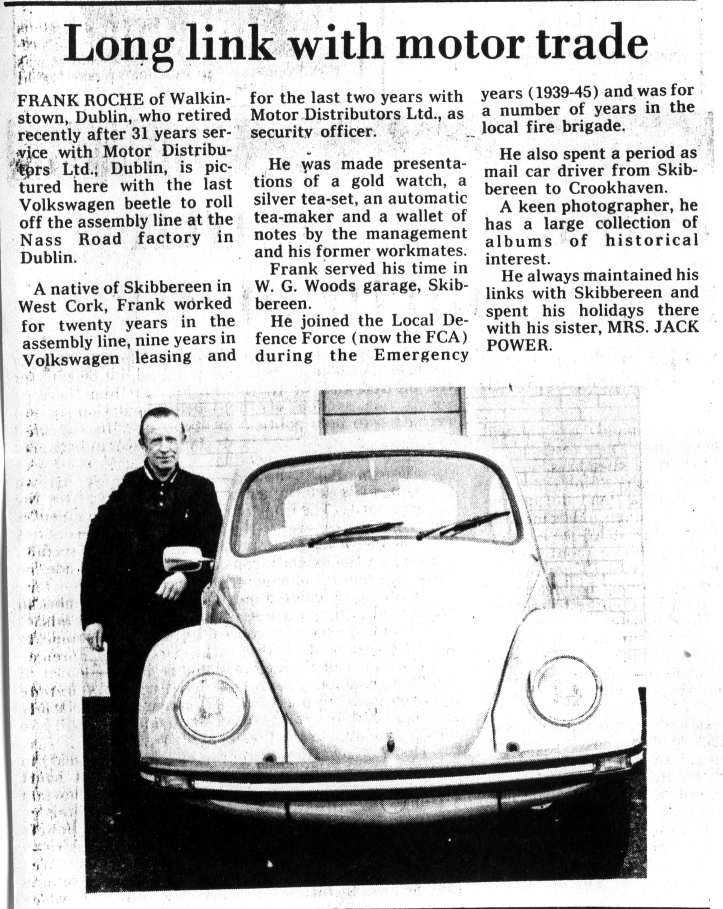Handley-Page Halifax LL145, Skibbereen, Cork
On the 21st April 1944, a Halifax bomber of the Royal Air Forces 517 (Met) Squadron found itself in difficulty after a long weather reconnaissance mission over the Atlantic. Seeking a safe landing zone the crew of Halifax LL145 found themselves making landfall in the Cork town of Skibbereen. Eight young airmen had found safe haven.
M. Jennings of Skibbereen must have thought that his field,
located next to the river and town in the townland of Marsh, was
going to become an airfield, when for the second time in less
than a month, an Allied bomber chose his field to make an
emergency landing. On March 16th previous, an American B-26 Marauder had made an
emergency landing in the same field next to Skibbereen
town. Clicking on the above link will bring you to that
crash story.
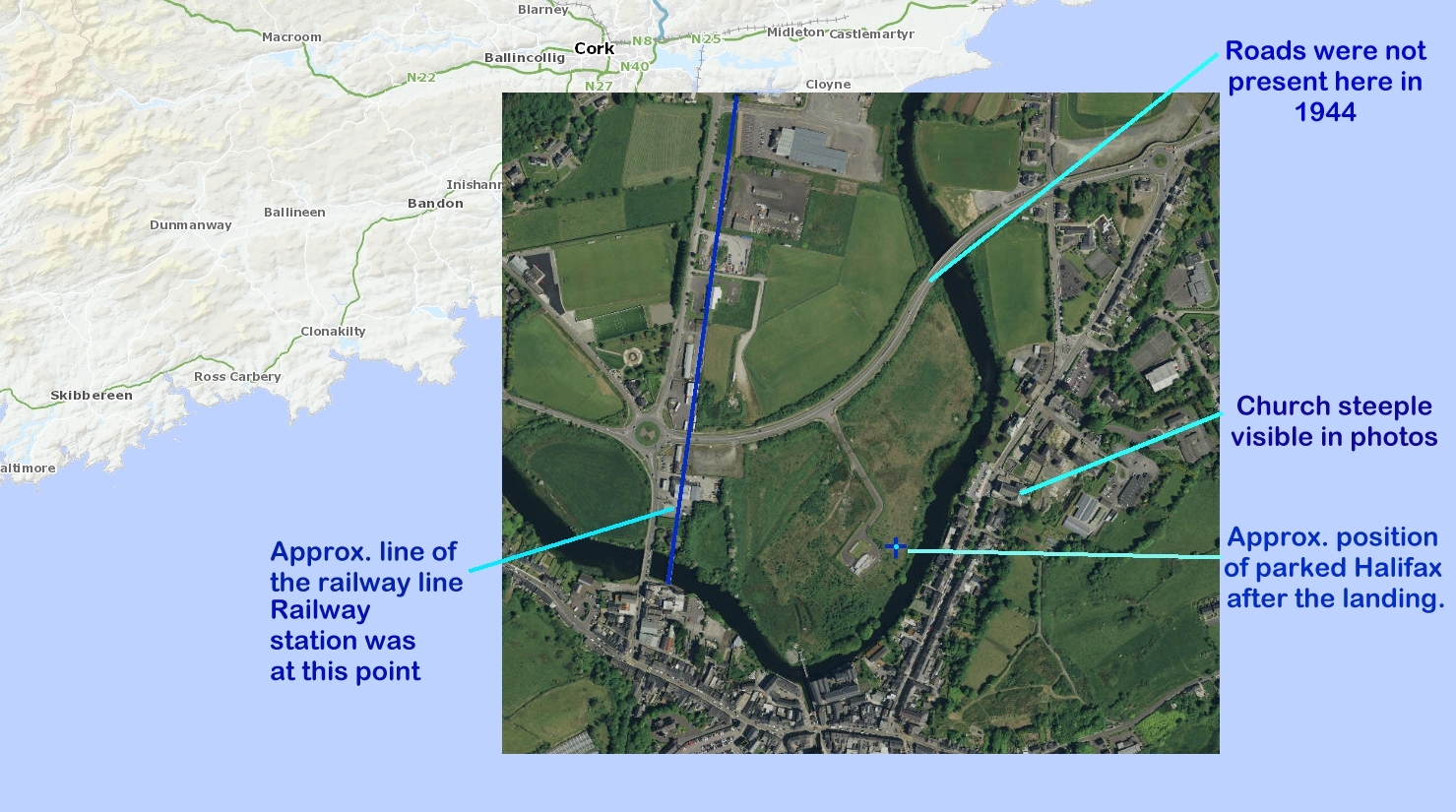
The incident of April 21st 1944 is recorded in the Irish Army reports G2/X/1307 and ACF-S-217. Prior to the landing, the aircraft had been reported flying around the south Cork area by Irish Army posts and police stations of the Garda Siochana.
The station master of Skibbereen station, Thomas "Toss" Barry,
later reported, on April 21, 1944, at mid day, he lit some straw
to attract the attention of an aircraft flying around the town.
The aircraft, a Halifax bomber, landed thereafter at 12:16.
bounced twice, passed through a fence and hit a grazing heifer.
The unfortunate animal subsequently had to be destroyed.
Members of the Local Defence Force (LDF) took the crew into
custody at the site until regular Irish Army troops could
arrive.
Local Skibbereen man Frank Roche seems to have been able to get quite free access to the aircraft during this time as he was able to send a number of pictures of its arrival and dismantling to John Poune. John's widow then in 2007 very kindly sent on copies of these which I shown below. Photos taken by Frank on what seems to be the day of the arrival are shown below. It shows the aircraft very close to houses in the town.
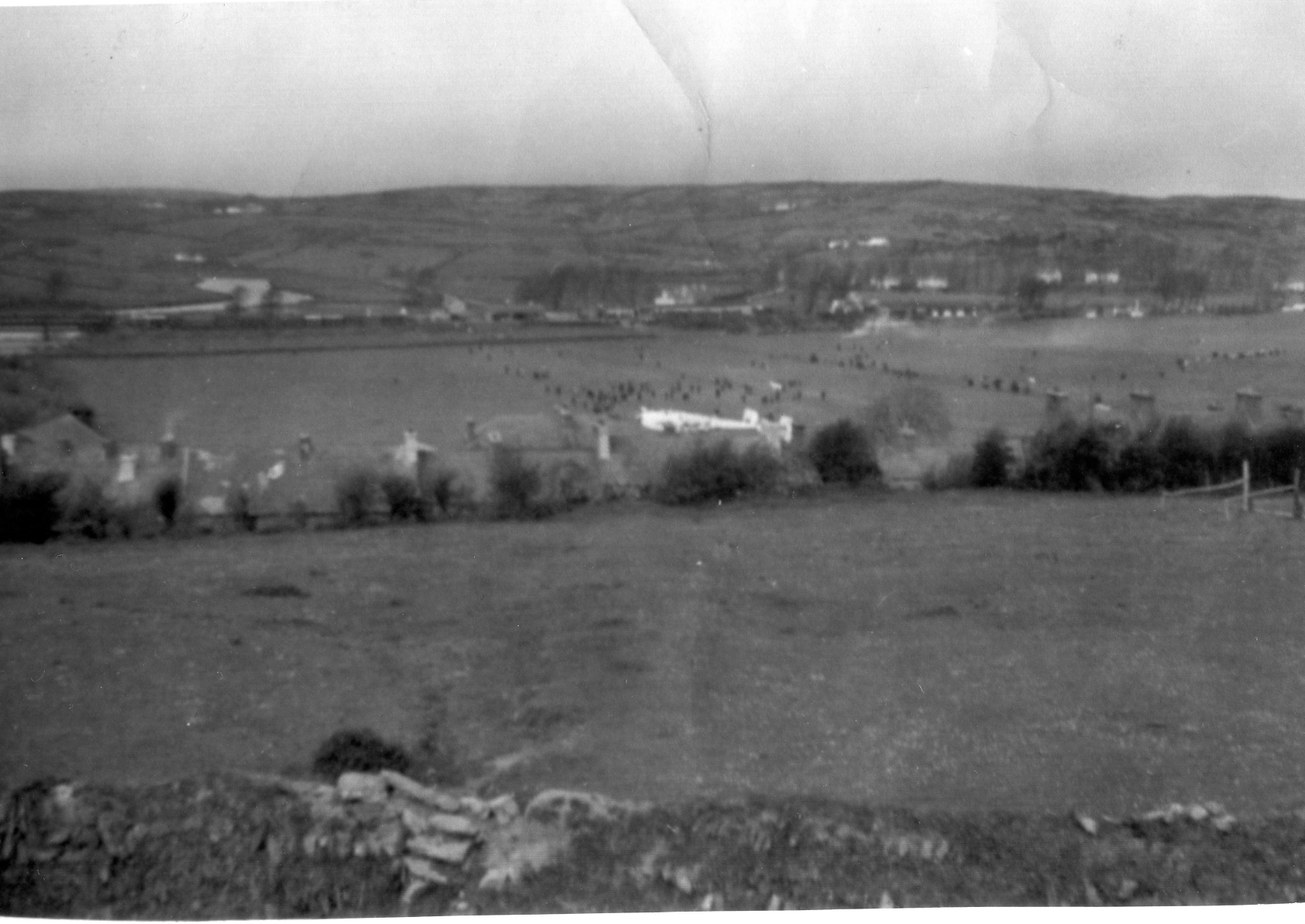
The above image appears to be take on a height looking down
onto the town and the Marsh field. The river can be seen in the
background. It seems that based on the photos below, that
this image was taken from above North Street in the town, which
runs North-North-West towards St Patrick's Catholic
Cathedral. The roof tops of the buildings either side of
North Street can be seen and between them and the aircraft is
the River Ilen. People can be seen swarming on the Marsh
in the image, in what must have been quite a spectacle.
This image is fascinating in that people are clearly rushing
across the field to the aircraft, including one individiual in
uniform, perhaps a Garda (policeman).
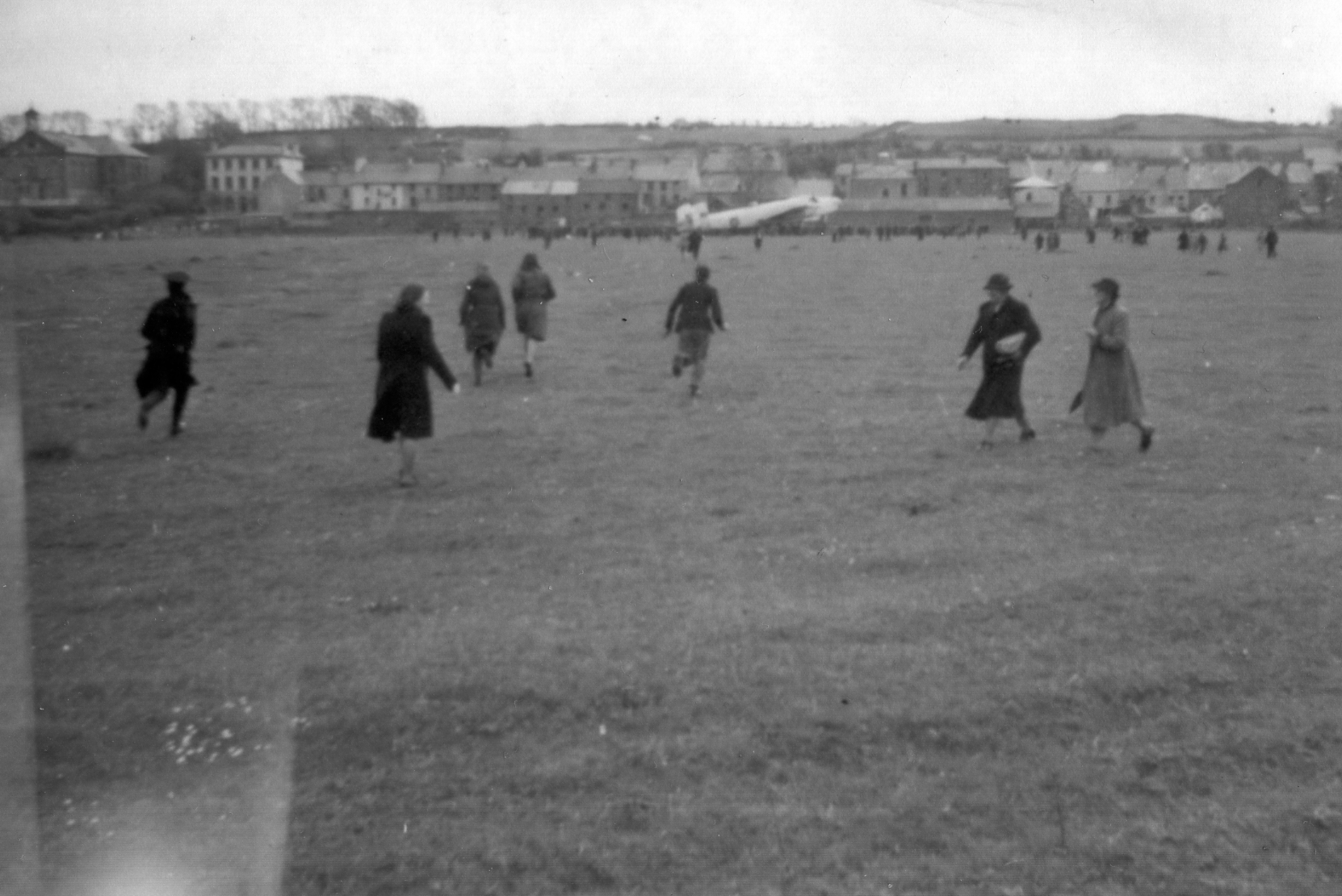
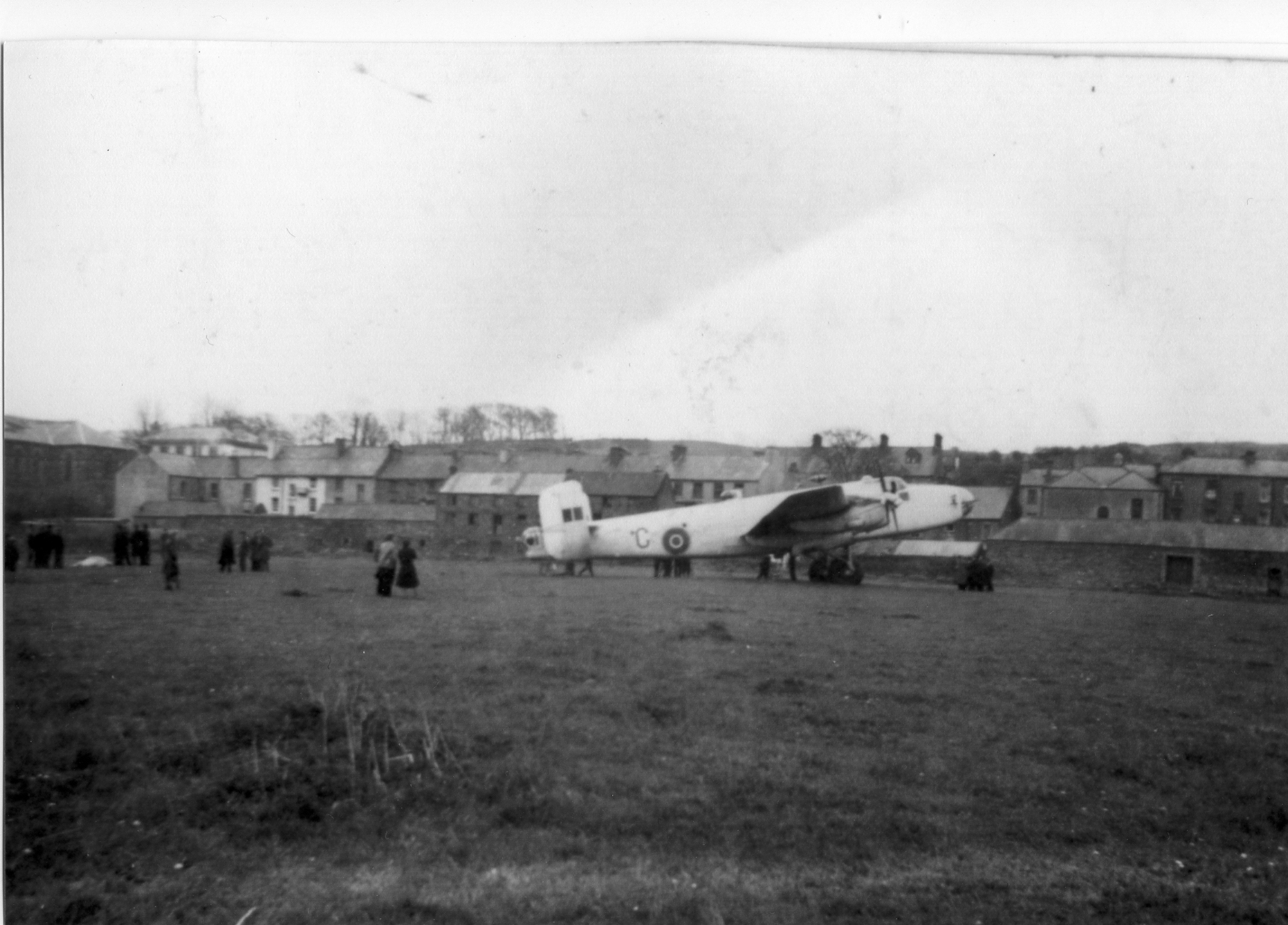
This photo then provides the best clue to the position of the
aircraft. The roof of St Patrick's Cathedral can be made
out on the extreme left of the photo, with the upper floor and
roof of the bank building visible next too it. Members of
the public can be seen in the photo.
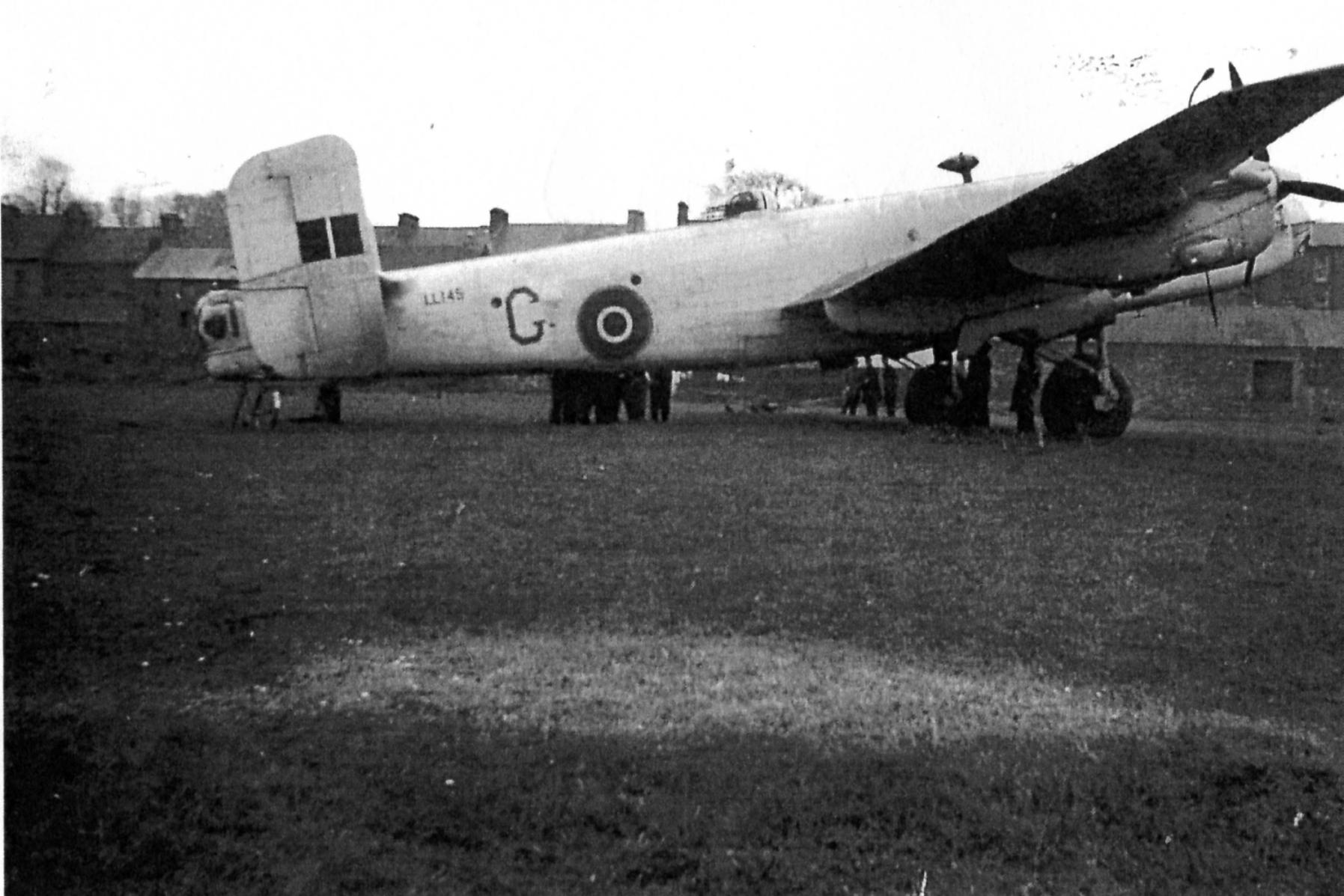
Frank has gotten in very close to the aircraft at this point
and the aircraft serial number LL145 along with the individual
aircraft code , G, are very visible.
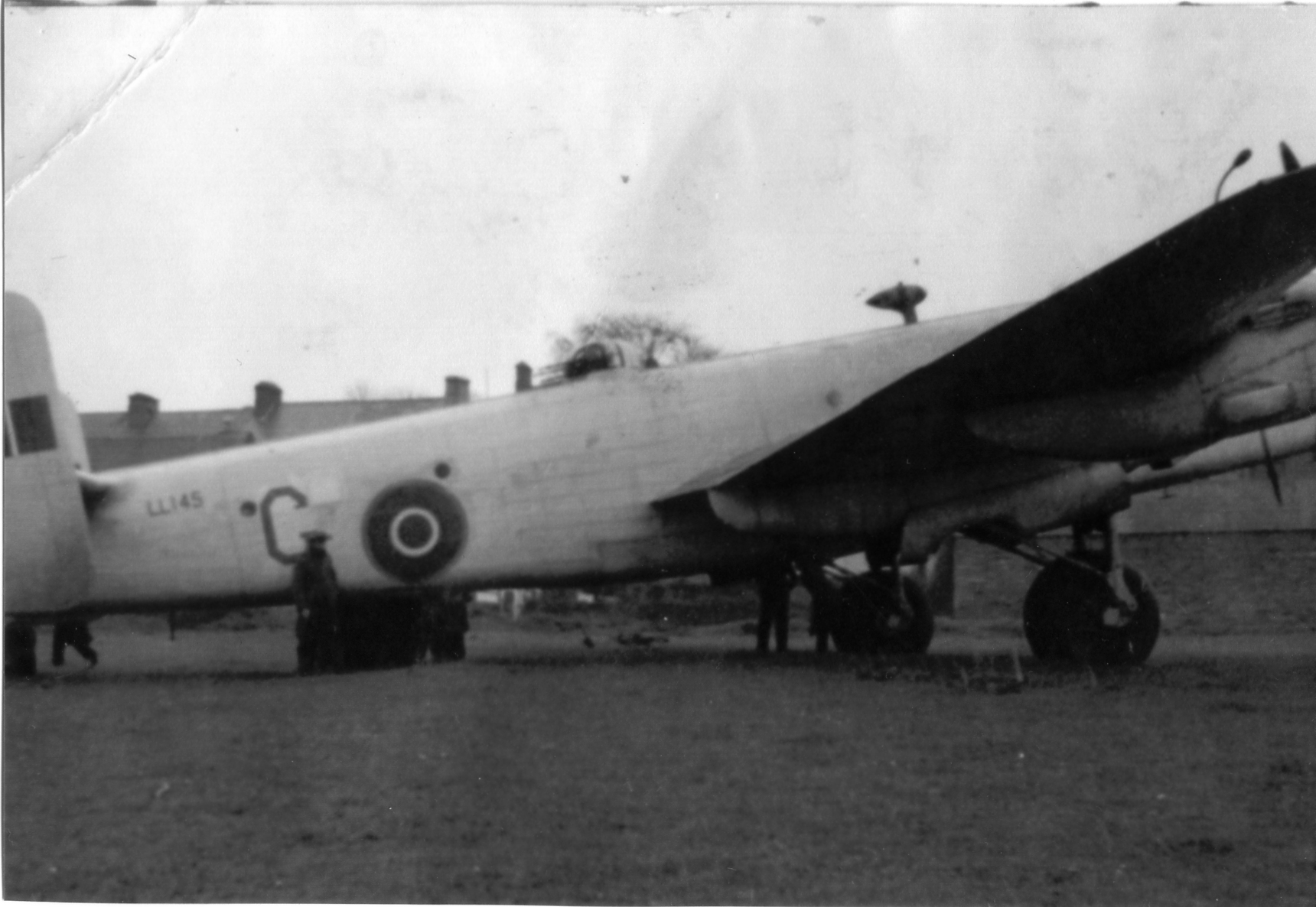
Another closer view of the right hand side of LL145 at rest on
the Marsh.
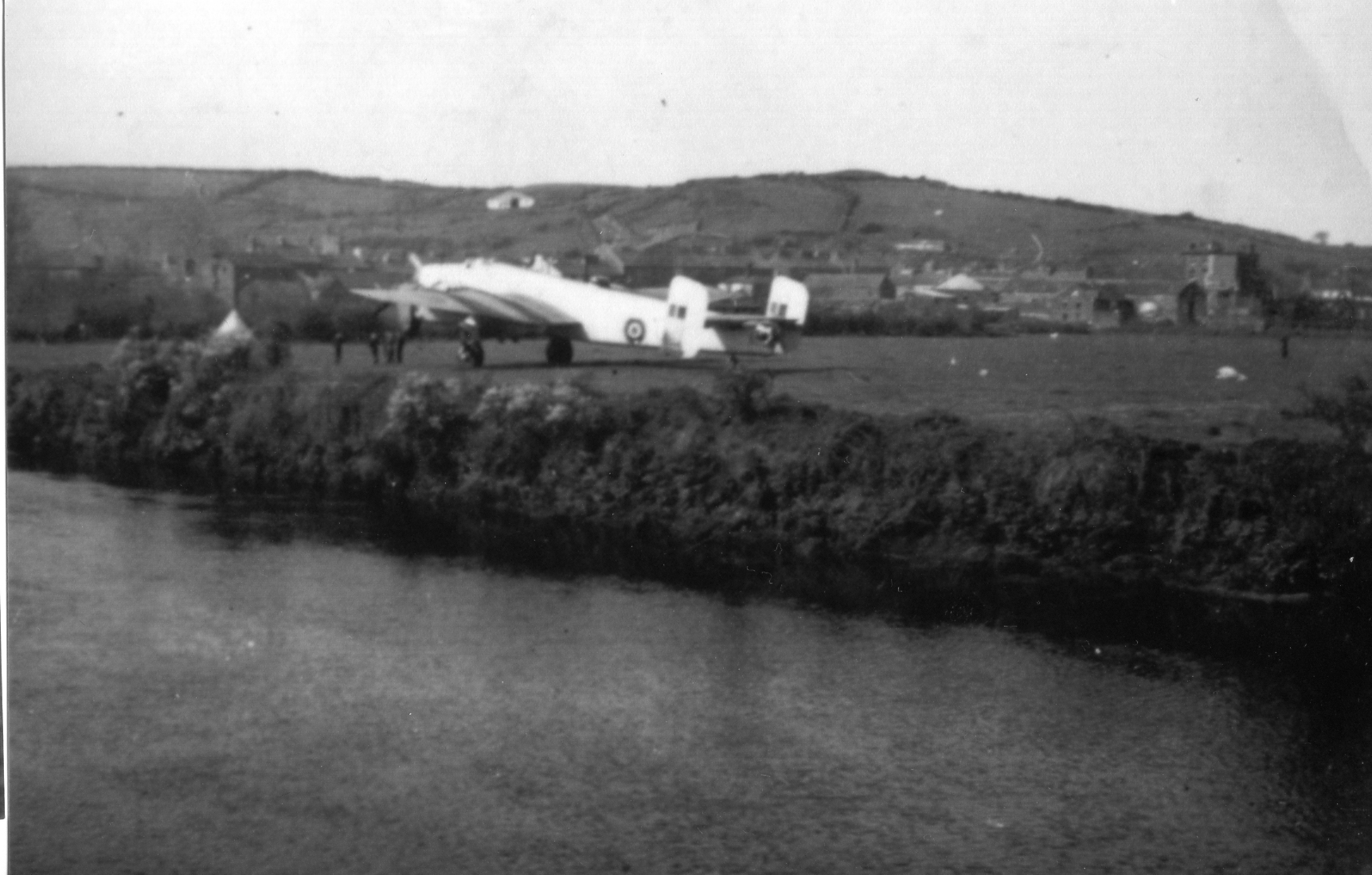
Above, shows LL145 being approached from the rear left from the
far side of the river.
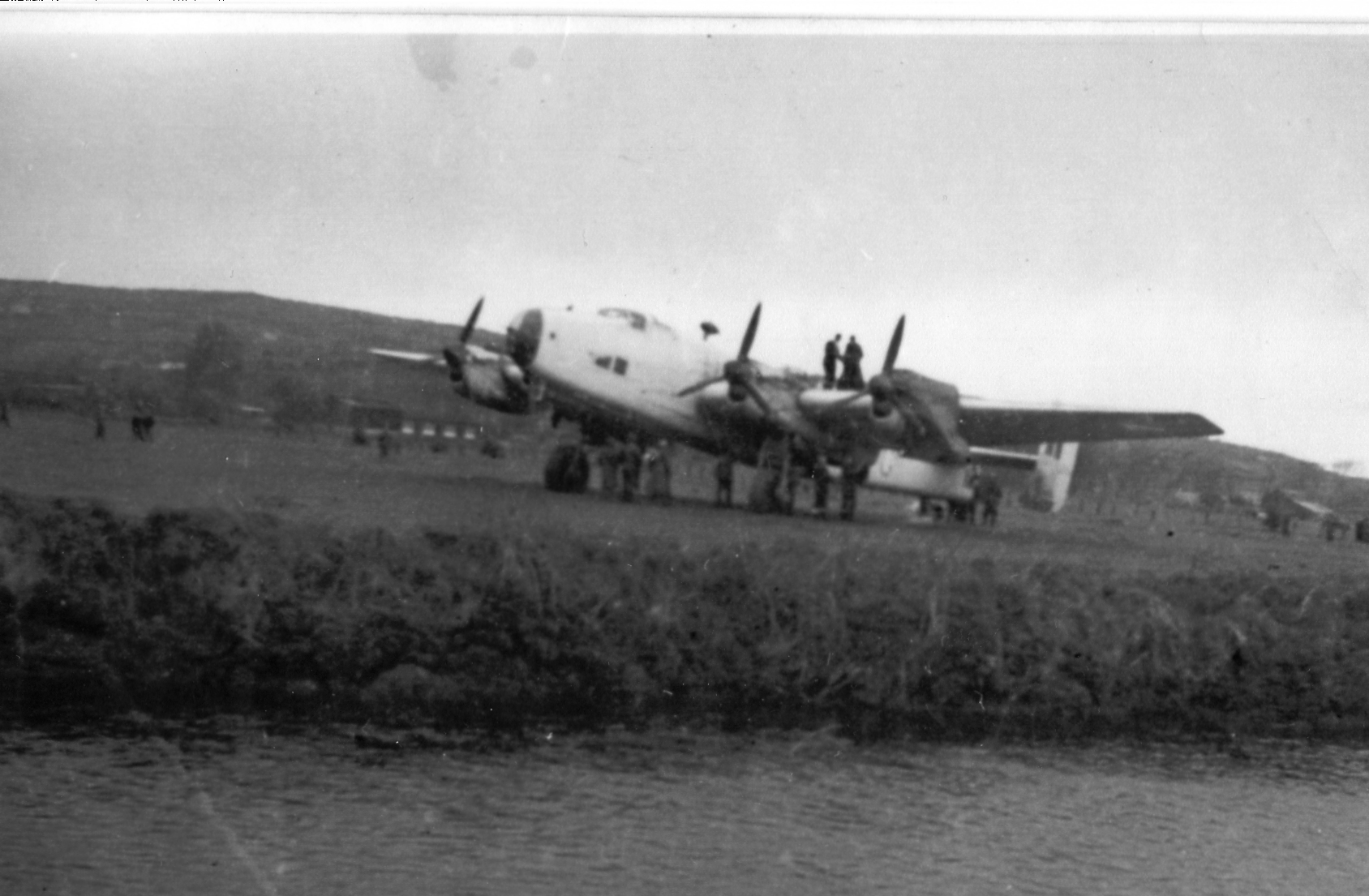
This image again from across the river, with people stood on
the wing, seems to show an engine cover having been placed on
the left outer engine. The aircraft while it looks to be
painted white all over would have had a green and grey
camouflage pattern on the top of the wings and tail plane and
probably on the top of the fuselage also.
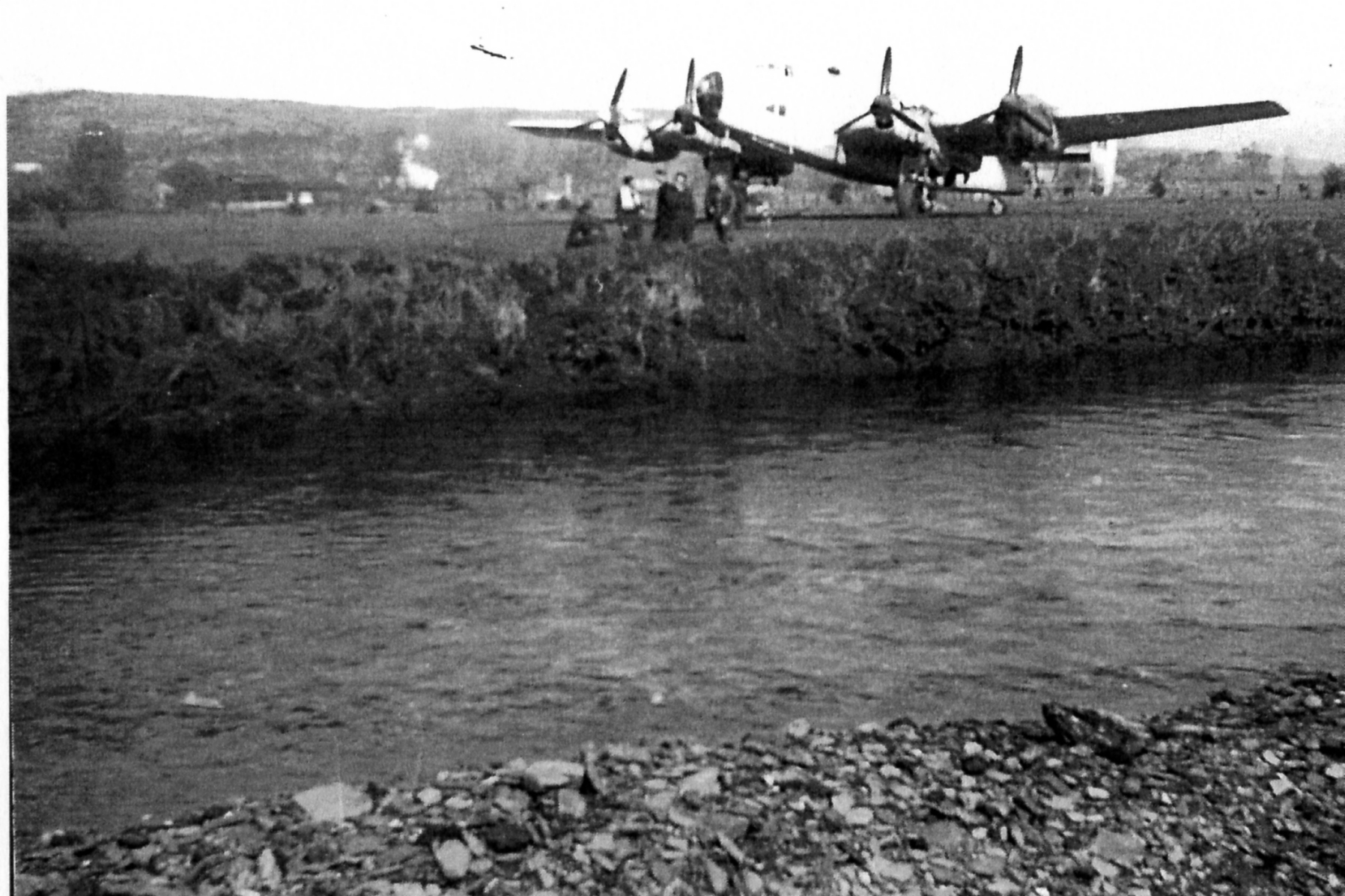
The above photo is a closer cropped version of the one below
and it may show some of the crew members talking across the
river. One individual may still be wearing a Mae West life
preserver.
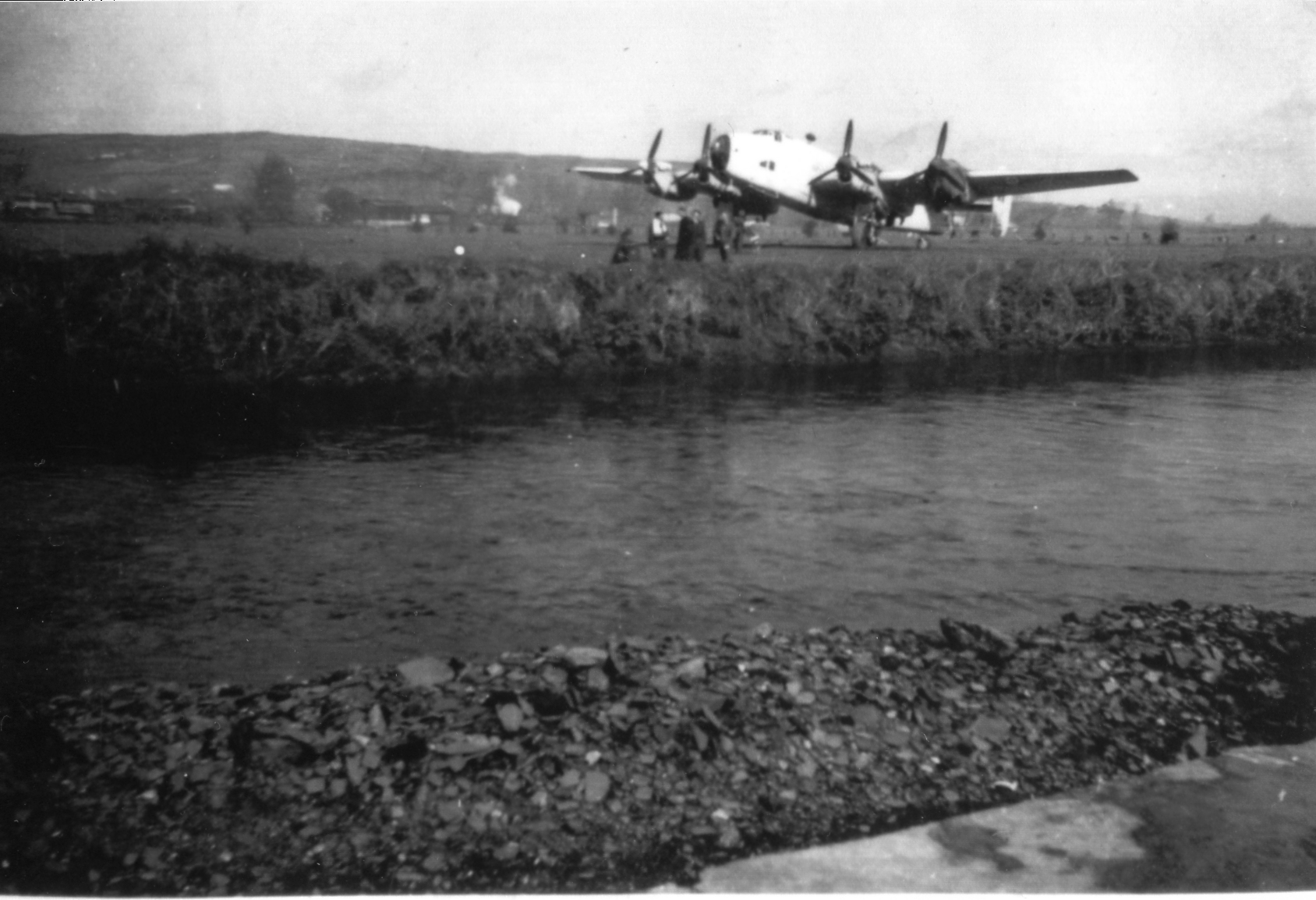
The same image as above but of wider field of view.
It was possible then after some searching to make contact with
all bar the Ashworth family, Arthur Ashworth having been an only
child.
Below is a composite photo showing the crew who were on board
Halifax LL145 on April 21st, 1944.
[Standing] W/O AG; A Mitchinson - 1st Pilot A Ashworth - WO/AG F
J Poune -
[Kneeling] 2nd Pilot J Musk - Navigator A S Lawes - WO/AG R
Wright -
[Inset left] Sgt D Travers - [Inset Right] Sgt Sgt J A Bartram
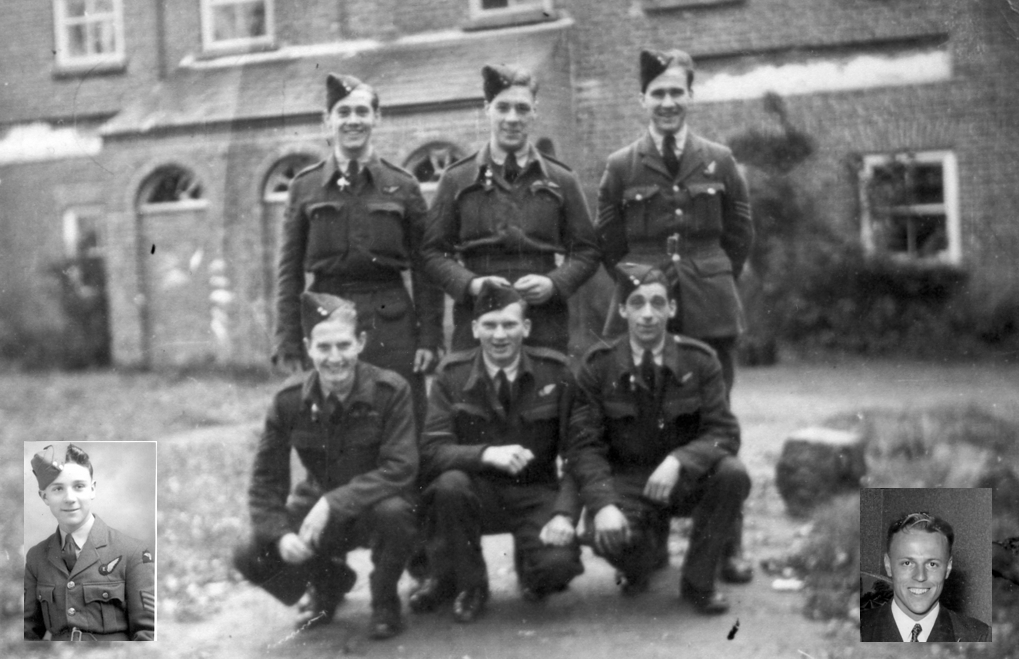
The Irish Army recorded the names of those on board and using
the information received in this research their correct
identities were:
Sgt Arthur W Ashworth 1474249, Pilot, of Hayburn
Court, Shipley, Yorkshire (See below)
Sgt Jack Musk 1331422 Co-Pilot, of 67A Higher Bents
Lane, Bredbury, Nr. Stockport (The Irish Army recorded his
name as John)
F/Sgt Alan Stewart Lawes 417206 RAAF Observer
(Navigator) of Moore St., Gawler, New South Wales, Australia
Sgt. Donald Travers 1819689 Engineer, of Stapleford,
Nottingham
Sgt Alan Mitchinson 1040987 Wireless Operator / Air
Gunner (WO/AG), of Rossmere, Stockton Road, West Hartlepool, Co.
Durham
Sgt Robert Wright 656650 WO/AG, of Westquarter, Falkirk,
Stirlingshire
Sgt Frederick John Poune 1336836 WO/AG, of Boulton St,
Alvaston, Derby
Sgt John Alan Barthram 1876801 Meteorological Officer of
Newivham Manor, Crownmarsh, nr Wallingford, Berks
The crew first reported that they were undertaking a search and
rescue mission but the Irish Army report later records that they
did admit to being on a Meteorological reconnaissance flight out
into the Bay of Biscay from their base of “St. Davids” (sic),
Wales.
Gerald O'Brien, of Skibbereen recalled "Now
72 years old, I have retained a vivid memory of the events
of that day of April of '44 all through my life.
I was just turned nine at the time and, not
surprisingly, I was in class at school when the drama
began. Our first apprehension was that of sound - a
very loud roar from the four 1800 hp Bristol Hercules aero
engines roaring over our heads, not much short of roof-top
altitude as the cool headed Pilot, with great skill, coaxed
the aircraft from the skies onto a large field, known as
"The Marsh", right beside the town. Fearful for our
safety, the Headmaster ordered all out of school without
delay into the adjoining play yard. I am glad he
did so, for it was from there that I had witnessed the image
of the Halifax on her last circling before coming to
earth. The surrounding buildings precluded all
possibility of seeing the actual touch-down. Suddenly
the noise had ceased, after which we were ordered back to
our seats in the class rooms. Before resuming studies,
our teacher told us that all was well, that the 'plane which
we had seen had by then "landed safely on the Marsh".
At lunch time, we got a fine view of the undamaged
bomber resting on the grass, across the river, from a porch
off North Street."
One of the crew men, Arthur Ashworth is reported to have
requested a doctor and upon being seen was confined to bed for 2
days although little else is mentioned about this and it is
unknown if he missed the ensuing entertainment. The aircraft and
it's crew had by now become a center of local attention with the
aircraft visible from across the river. In an effort to
show them hospitality before being processed by the authorities
they were taken to the nearby West Cork Hotel and Alan's
description above relates the story thereafter. The local
Red Cross members attempted to invite the men to a local dance
but were refused permission by the military authorities due to
the level of hospitality shown to the them already! The
crew were accommodated in the West Cork Hotel. The files
report that on April 23rd, seven men were brought to Rinneanna
military post, the location of modern day Shannon airport.
Later that day they were further driven to the border with
Northern Ireland and handed over to the British
authorities. Both John Poune's and Robert Wright's log
books shows that some or all of the crew were picked up at
Ballyhalbert airfield in Northern Ireland by Halifax 'C' of 517
Sqn on April 25th to return to their base.
Pat MacCarthy from Drinagh, Cork, then a member of the Irish
Army 2nd Cycle Squadron based at Bantry and then a retired
farmer of 88 years, wrote in reply to the letter in the Southern
Star: "In my youth I was a member
of the Irish Army and one of those who took over
responsibility for the Halifax bomber after the landing on
the March near Skibbereen town"
"This plane was later dismantled and transported
across the border into Northern Ireland in exchange for a
consignment of tea as this was a very scare commodity in
Ireland at the time.
At the time the pilot made a perfect wheels down
landing on the Marsh with nothing to guide him but his own
good judgment. This was a great achievement to be able
to land a four engined Halifax bomber plane with out the use
of any modern technology."
Pat was photographed by local Skibbereen photographer Frank
Roche with five of his comrades standing below the partially
dismantled hulk of the bomber. This photo appeared in a
1985 copy of the Southern Star where some of the veterans
remembered they had to pitch tent on the Marsh while the aircrew
were accommodated in the West Cork Hotel.
Local man Cornelius Connolly reported to Gerald O'Brien in late
2007 that he recalled, also having seen an aircraft land on the
marsh, that before there was any dialogue with the LDF personnel
on the ground, "the entire crew lined
up to give a special salute to the Pilot, of thanks and
admiration for what he had just accomplished".
The aircraft, Handley Page Halifax V, serial number LL145, of
RAF 517 (Meteorological) Squadron, had taken off for an 'Epicure
B' weather reconnaissance flight over the Bay of Biscay from its
base at Brawdy in Wales at 01:15 that day. The route was
planned as Brawdy - 45N 08W - 43N 14W - Brawdy (positions
approximate).
Eleven and a half hours later they had to make their impromptu
visit to Skibbereen. The 517 Squadron Operations Record
Book barely mentions the flight, simply recording it as
'aircraft landed away from base'.
Tragically, two members of the crew that day would be
dead before the end of 1944, Jack Musk and Arthur
Ashworth. Both were lost at sea while on flying
operations.
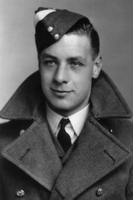 Arthur W Ashworth, aged 21, was lost at
sea on the 30th July 1944 when Wellington HF449 of 172 Squadron
was lost after having radioed that they were going to make an
attack on a submarine. Arthur is remembered on panel 215
of the Runnymede Memorial to RAF Airmen whose remains were never
recovered. Arthur was the son of Herbert and Gladys Mary
Ashworth, of Shipley but who later moved to Hest Bank,
Lancashire. Speaking to local's in Hest Bank in 2007,
revealed that the family no longer lived in the area but there
was a memory that a family named Ashworth did live in the
village. The Bradford Library local history office was
able to find a small article in the Bradford Telegraph and
Argus, from March 12, 1943. L.A.C. Ashworth received his 'wings'
at a flying training school at Estevan, Saskatchewan, Canada,
most probably with 38 Service Flying training School and passed
as a bomber pilot. He attended Keighley Grammar School, and was
formerly a member of the Shipley (387) A.T.C. Squadron. Aged 19,
he was previously employed by a firm of accountants. His
parents, Herbert and Gladys Ashworth, lived at 43, Leyburn
Grove, Shipley. Sadly, Arthur was their only child.
A letter in the local paper however found four people who knew
Arthur and his parents. One former RAF airman called to
say that he knew Arthur when both of them served in the ATC and
he went on to serve alongside Arthur at RAF Chivenor where 172
Squadron was based and had nice memories of Arthur.
Another very kind friend of the family contacted to tell what
they knew. Mrs. J Walker's family moved to the same street
as the Ashworth’s in 1943. She never met Arthur herself as
he was away on service but one thing she remembers clearly is
that Arthur once sent a crate of Banana's to his parents from
his overseas service, perhaps from a trip to North Africa or
else where. His instructions were that all the children of
the street were to get one. Later, Herbert and Gladys
moved away and eventually lived in Hest Bank where they are
named on the CWGC records. Gladys passed away in the early
1960's. Mrs. Nancy Gingell called also to say she
remembered the Ashworth’s from their time both in Shipley and
Hest Bank. Her brother Dickie Wadsworth had been very
close friends with Arthur and the two of them lost their lives
in separate aircraft losses within weeks of each other in
1944. Finally, a school friend of both Arthur and Dickie
Wadsworth, Mr. Harry Clough wrote to include his memories of
Arthur. Both he and Arthur had worked as article clerks
for the same accountant in Bradford. He recalls Alan Lawes
visiting on leave with Arthur and they also became friends.
Arthur W Ashworth, aged 21, was lost at
sea on the 30th July 1944 when Wellington HF449 of 172 Squadron
was lost after having radioed that they were going to make an
attack on a submarine. Arthur is remembered on panel 215
of the Runnymede Memorial to RAF Airmen whose remains were never
recovered. Arthur was the son of Herbert and Gladys Mary
Ashworth, of Shipley but who later moved to Hest Bank,
Lancashire. Speaking to local's in Hest Bank in 2007,
revealed that the family no longer lived in the area but there
was a memory that a family named Ashworth did live in the
village. The Bradford Library local history office was
able to find a small article in the Bradford Telegraph and
Argus, from March 12, 1943. L.A.C. Ashworth received his 'wings'
at a flying training school at Estevan, Saskatchewan, Canada,
most probably with 38 Service Flying training School and passed
as a bomber pilot. He attended Keighley Grammar School, and was
formerly a member of the Shipley (387) A.T.C. Squadron. Aged 19,
he was previously employed by a firm of accountants. His
parents, Herbert and Gladys Ashworth, lived at 43, Leyburn
Grove, Shipley. Sadly, Arthur was their only child.
A letter in the local paper however found four people who knew
Arthur and his parents. One former RAF airman called to
say that he knew Arthur when both of them served in the ATC and
he went on to serve alongside Arthur at RAF Chivenor where 172
Squadron was based and had nice memories of Arthur.
Another very kind friend of the family contacted to tell what
they knew. Mrs. J Walker's family moved to the same street
as the Ashworth’s in 1943. She never met Arthur herself as
he was away on service but one thing she remembers clearly is
that Arthur once sent a crate of Banana's to his parents from
his overseas service, perhaps from a trip to North Africa or
else where. His instructions were that all the children of
the street were to get one. Later, Herbert and Gladys
moved away and eventually lived in Hest Bank where they are
named on the CWGC records. Gladys passed away in the early
1960's. Mrs. Nancy Gingell called also to say she
remembered the Ashworth’s from their time both in Shipley and
Hest Bank. Her brother Dickie Wadsworth had been very
close friends with Arthur and the two of them lost their lives
in separate aircraft losses within weeks of each other in
1944. Finally, a school friend of both Arthur and Dickie
Wadsworth, Mr. Harry Clough wrote to include his memories of
Arthur. Both he and Arthur had worked as article clerks
for the same accountant in Bradford. He recalls Alan Lawes
visiting on leave with Arthur and they also became friends.
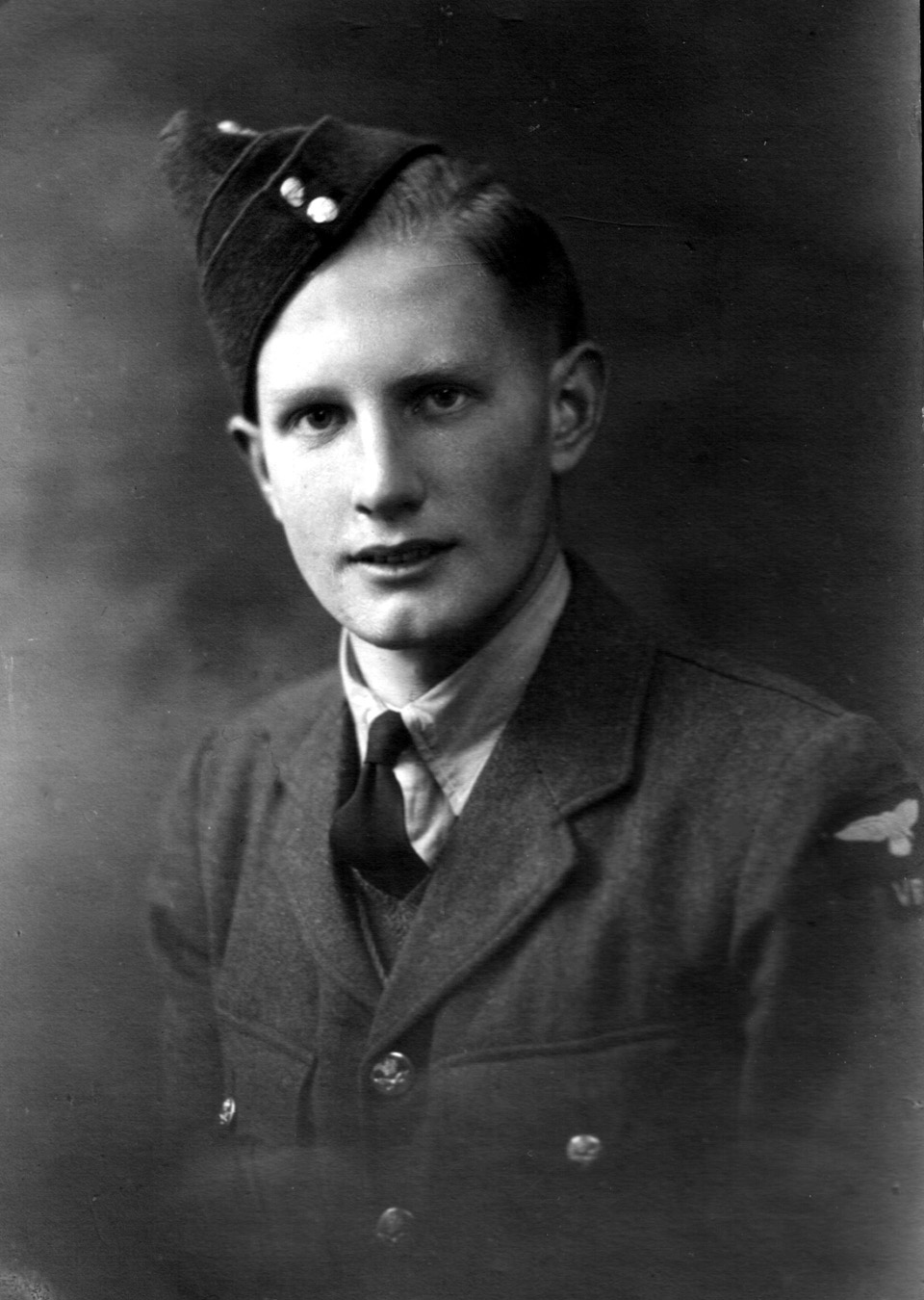 Jack
Musk, aged 22, was lost on November 10, 1944 when the
Halifax of 518 Squadron he was with reported an engine
failure. Nothing further was heard from Halifax LK706, L
for Love, or its eight man crew. Jack is remembered on
Panel 220 of the Runnymede Memorial. His niece's husband
Mike Brown has researched Jack's life and wartime
career. It was because of Mike's letter about Jack in the
Macclesfield School 2006 Gazette Newsletter that I was able to
make contact with him. He was married in December 1943 and
he and his wife Joan lived at Higher Bents Lane in Bredbury near
his parents. His story is presented below from Mike
Brown’s letter in the The King's School in Macclesfield Gazette.
Jack
Musk, aged 22, was lost on November 10, 1944 when the
Halifax of 518 Squadron he was with reported an engine
failure. Nothing further was heard from Halifax LK706, L
for Love, or its eight man crew. Jack is remembered on
Panel 220 of the Runnymede Memorial. His niece's husband
Mike Brown has researched Jack's life and wartime
career. It was because of Mike's letter about Jack in the
Macclesfield School 2006 Gazette Newsletter that I was able to
make contact with him. He was married in December 1943 and
he and his wife Joan lived at Higher Bents Lane in Bredbury near
his parents. His story is presented below from Mike
Brown’s letter in the The King's School in Macclesfield Gazette.
While Ashworth and Musk were very soon posted away from 517
Squadron, they were replaced by two new pilots, Frank William
John KEMP (46248) and Eric PEPPER (152459). The core crew
team for the remainder of the war remained then as Kemp, Pepper,
Lawes, Travers, Mitchinson, Wright and Poune. The met
observer varied but they did fly often with a Sgt W F Hall.
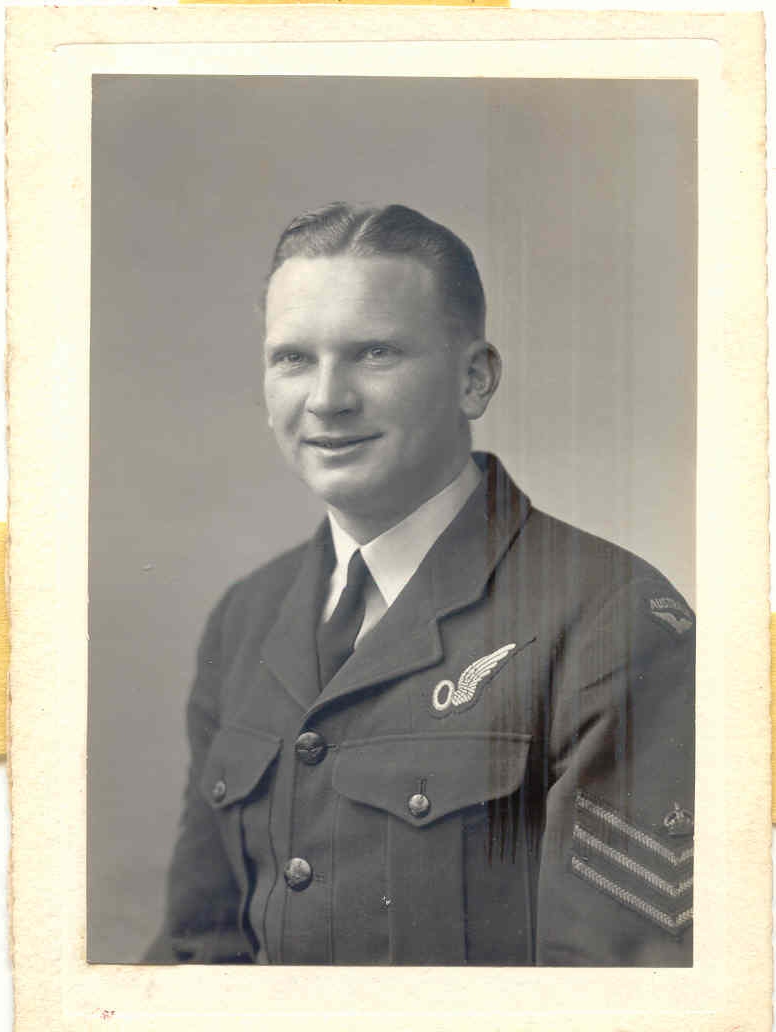 The
Australian National Archives and Australian War Museum Nominal
Roll both list Alan Stewart Lawes as coming from Gawler.
I mailed the local newspaper and within a week Heather was able
to contact me. Alan Lawes passed away in June 2004.
He was the local President of Returned Soldiers League for many
years, and a State Councilor for 11 years. It seems that
Alan tried to convince both Don Travers and Robert Wright to
move to Australia after the war's end but neither of them made
the move. Heather recalls that Alan never mentioned much
about the war but he did tell them some stories
The
Australian National Archives and Australian War Museum Nominal
Roll both list Alan Stewart Lawes as coming from Gawler.
I mailed the local newspaper and within a week Heather was able
to contact me. Alan Lawes passed away in June 2004.
He was the local President of Returned Soldiers League for many
years, and a State Councilor for 11 years. It seems that
Alan tried to convince both Don Travers and Robert Wright to
move to Australia after the war's end but neither of them made
the move. Heather recalls that Alan never mentioned much
about the war but he did tell them some stories
"We did know a bit about Ireland but
the story like all of his war tales came in fragments.
Dad was a navigator in the Halifaxes and I remember Dad
saying … they had gone off course…not sure why…. Maybe
something went wrong with some instruments…. they ran
out of fuel and were forced to land … the words he used were
they were ‘interned’ in Ireland. I have this vague
recollection that stuck in my mind that they had to eat?
papers before they landed…. That bit stuck in my mind from a
very early age. I vaguely remember him saying they also had
to burn papers in the plane before they landed… all of which
I would have imagined to be highly dangerous. These papers
were obviously highly secretive and not to enter enemies
hands.
My older brother Barry thinks that when Dad’s crew
crash landed they managed to land but the plane was badly
damaged and couldn’t be flown back."
I found it interesting that you mentioned the date of
21st April … so close to Anzac day. Dad always treasured the
25th April (ANZAC day) for Australians that day is very
significant."
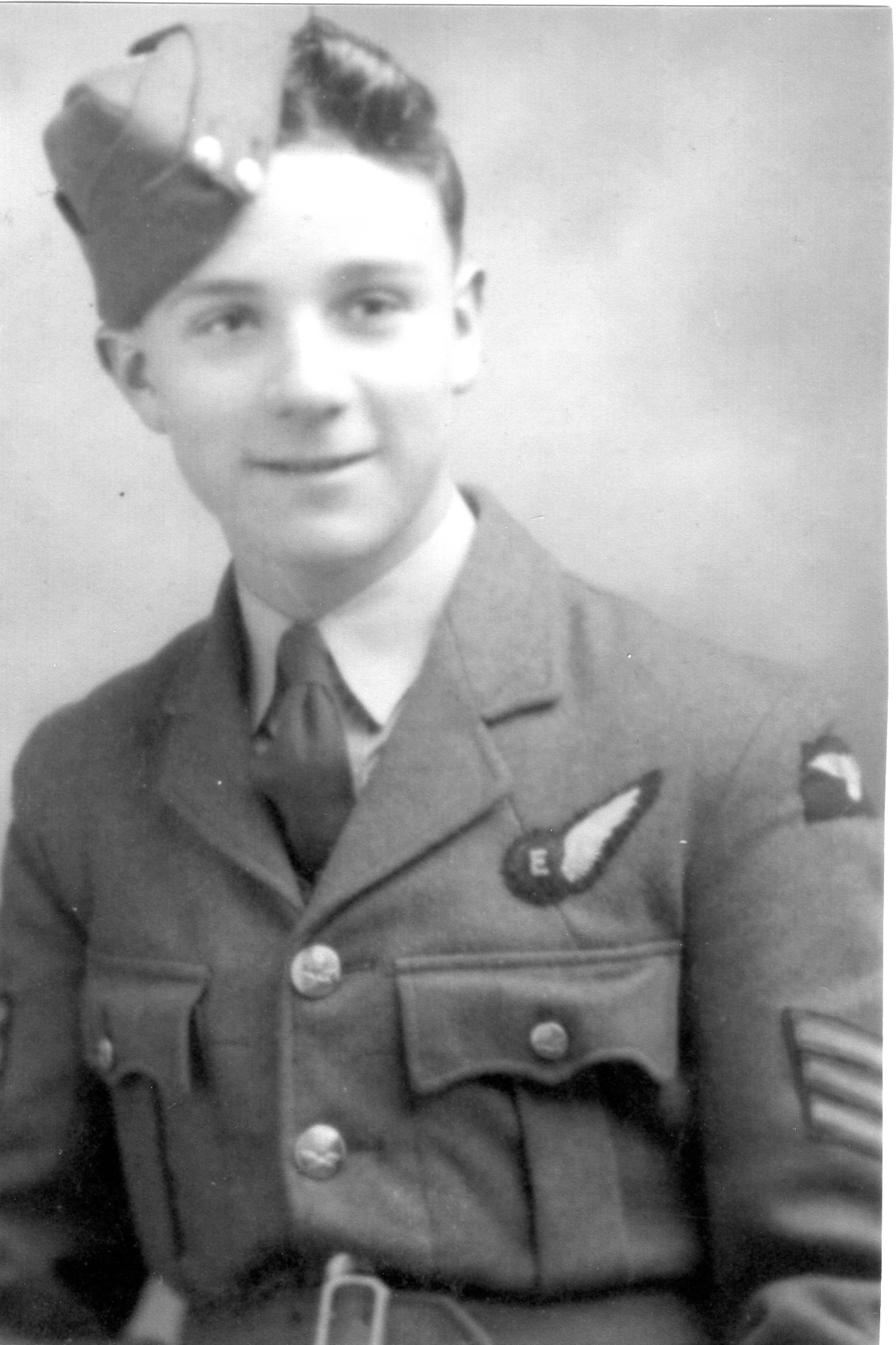
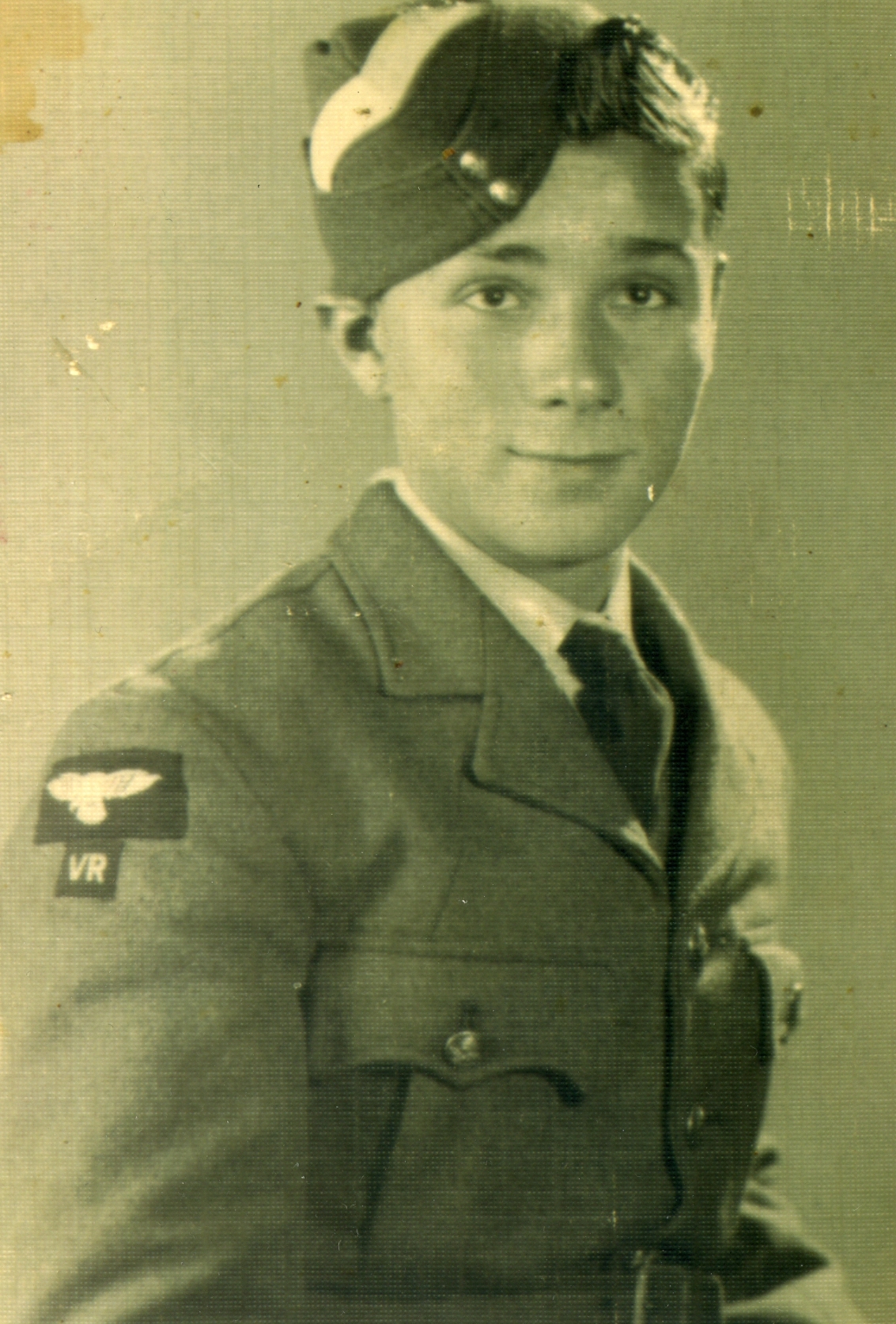 The flight Engineer on
the aircraft was 19 year old Donald Travers from
Stapleford, son of Hilda and Cyril Travers.
The flight Engineer on
the aircraft was 19 year old Donald Travers from
Stapleford, son of Hilda and Cyril Travers.
Don Travers sisters, in 2007, still lived at the address that
Don gave to the Irish Army all the way back in 1944. He
was able to retell a quite a story however.
Glennis Travers, sister of Donald Travers, recounted Donald’s
story:
"He remembers the Skibbereen incident
and he really appreciated hearing your letter. He said
it had been an interesting afternoon.
Don often used to bring Air Force mates with him when
he came home on leave and we think that Fred Pounes may have
been one of those who came. Alan Lawes is a name that
Jean and I remember well though we're not certain that he
actually came to the house.
Don was only 19 at the time of Skibbereen and we think
he was the youngest member of the crew. He may, I
think, have had the nickname 'Titch'. He is non too
tall.
Your letter was most interesting to us as until then,
although we were familiar with the Skibbereen incident and
"being held prisoner in the pub!", we did not know the full
details of the circumstances which led to the emergency
landing, nor did we know the name of the pub/hotel where
they were housed. We did, however, know that
they landed in a field and unfortunately hit a cow.
Over the years Don's told us many stories of his time
there and we must extend our thanks to the people of
Skibbereen for their kindness and generosity to Don and the
rest of the crew at that time.
Being on duty, Don of course, only had his flying
boots as footwear and one day whilst he was in the town,
someone in the town, presumably a resident, took him into a
shop and bought him a pair of shoes, allowing him to pick
any pair he wanted.
We've been given to understand, over the years, that
there actually was a dance to which the crew were invited.
On one occasion Don was a bit 'merry' one night (which
we seem to think was also the night of the dance) and when
he woke up the next morning, he found that five pounds had
been tucked into his pocket. Five pounds was quite a
considerable amount of money in those days.
We've also always understood that the local
authorities were originally going to allow them to fly the
aircraft out, but later decided against this on the grounds
that it was too close to the town for safety and that was
why it had to be dismantled.
Sorry, but we can't throw any light on who was writing
to the young lady you mentioned.
Regrettably his log book no longer exist.
517 is the only squadron I can recall him mentioning.
Don volunteered for service whilst he was 17. He
was a Flight Engineer in Coastal Command. We
think he was demobbed sometime in 1946.
In his early days in the RAF he was based in the
Torquay area (this may possibly have been whilst
training). There was a bomb raid whilst he was there
and a school was hit. Don was among those who helped
with the rescue/recovery operation.
After being demobbed Don returned to his occupation as
a motor mechanic, and worked in the motor trade for many
years. At the time of his retirement, however, he was
working for British Rail in a supervisory capacity on the
engineering side."
One of Donald first postings was to Initial Training Wings in
Torquay in the spring of 1943. On Sunday 30th May 1943 the
St. Marychurch parish church was bombed in Torquay killing a
number of children. Donald then trained with the School of
Technical Training at St. Athan before being sent to the
Meteorological Conversion Unit (MCU) in January 1944 where he no
doubt met his future crew. His posting to the MCU and 517
Squadron matches that of Frederick Poune and Jack Musk. He
flew with 517 Squadron up until September 1945 where he was
posted to three training units, including 4 O.T.U which flew
Sunderland flying boats.
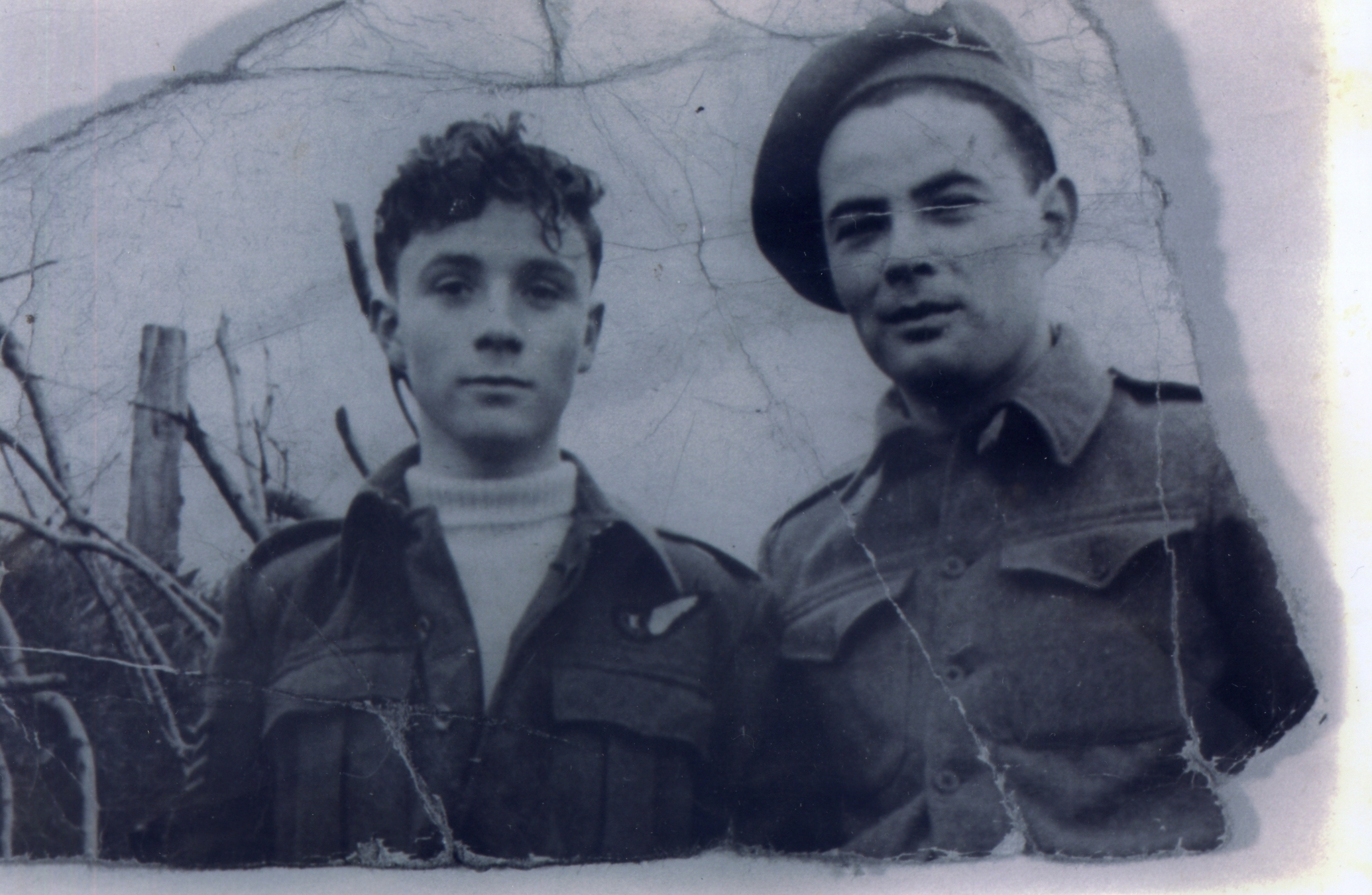 One small mystery was raised by
Donald Travers whose sister provided us with a copy of a rather
battered photo of Don standing beside an Irish army
soldier. The Southern Star newspaper were kind enough to
print the photo and a small letter. This raised the
interest of Gerald O'Brien quoted above and also succeeded in
finding the Irish soldiers identity. He was Denis Twomey,
a solicitor, then serving with the Local Defense Force (LDF) in
the area. His daughter, Ann Twomey Bell, recalled that she
heard 'many stories of about the 'capture' of the RAF men and
the wonderful time that followed!! He was a great pianist
and there was lots of music and song during the lock in".
Denis, sadly, passed away in 1992. He may well be the
gentleman that John Barthram remembers in his story above.
One small mystery was raised by
Donald Travers whose sister provided us with a copy of a rather
battered photo of Don standing beside an Irish army
soldier. The Southern Star newspaper were kind enough to
print the photo and a small letter. This raised the
interest of Gerald O'Brien quoted above and also succeeded in
finding the Irish soldiers identity. He was Denis Twomey,
a solicitor, then serving with the Local Defense Force (LDF) in
the area. His daughter, Ann Twomey Bell, recalled that she
heard 'many stories of about the 'capture' of the RAF men and
the wonderful time that followed!! He was a great pianist
and there was lots of music and song during the lock in".
Denis, sadly, passed away in 1992. He may well be the
gentleman that John Barthram remembers in his story above.
Donald Travers passed away in hospital in Nottingham in September 2008, after helping his sisters to recount what he could of the incident.
The family of Alan Mitchinson were very helpful in
their responses to my letter in a local Hartlepool paper.
Daughters, Jan and Anne and Son David were delighted to be shown
the collection of photos and to get details of the incident at
the heart of this story. Alan was born in the summer of
1923 to Florence and William Mitchinson. In the 1939
register, Alan is listed with his widowed mother and was at the
time an Apprentice plasterer.
Alan Mitchinson passed away in 1990 but had passed on the tale
of his adventures to his family over the years. Like Fred
Poune, Alan also joined the police after the war but returned to
his first trade, that of a plasterer, setting up his own
business in 1960's. David his son recalled of him "My father told me many years ago about
this event, although his words are now very vague I shall
always remember the gratitude he paid to the people of
Ireland who showed him grate respect and compassion. He said
he would never forget them."
David Mitchinson and his son visited Skibbereen in December 2007
to visit the town for themselves. Alan reported to me "The marsh in Skibbereen is now being
excavated for what appears to be a large Housing Development
as you had previously mentioned so it was no surprise to us
that we would find it difficult to imagine where the Halifax
V landed in relation to the town of Skibbereen, thanks to
photo's of events of that day we managed to pinpoint with
almost certainty where the Halifax came to rest and the
direction in which the Aircraft came in to land, can you
imagine our excitement, we only wish we could have walked to
the spot on the marsh where Dad and his bewildered crew
members had touched terra ferma, a moment missed for my son
and I but one I am sure my Dad always remembered.
Whilst staying in the West Cork
Hotel in Skibbereen we decided to tour the local area, we
couldn't help but notice the hills and mountains on our
journey to Baltimore where it was said the Halifax was seen
on that day flying over the southern part of the mainland, I
find it remarkable that given the terrain in this area the
pilot and crew of the Halifax ever found there way to the
marsh in Skibbereen, perhaps they followed the river Ille
inland until they came across what must have been utopia to
them when they spotted the marsh, a daunting task for any
pilot to land an aircraft of that size and weight given that
the ground must have been soft or waterlogged especially at
that time of the year, the marsh must have been the only
possible area where the pilot could have landed the
aircraft, an amazing feat for any pilot I would imagine
which makes it even more remarkable. You will also have
noticed that the pilot landed the Halifax very close to the
banks of the river Ille, this I believe was probably because
the ground close to the river would have been better drained
and perhaps a more favourable area on the marsh to land the
aircraft, who knows, either way looking at the area it was a
miracle that the Halifax landed in one piece, I couldn't
imagine that a wheels up landing was an option given the
size of the aircraft, it's gun turrets beneath and the size
of the propellers."
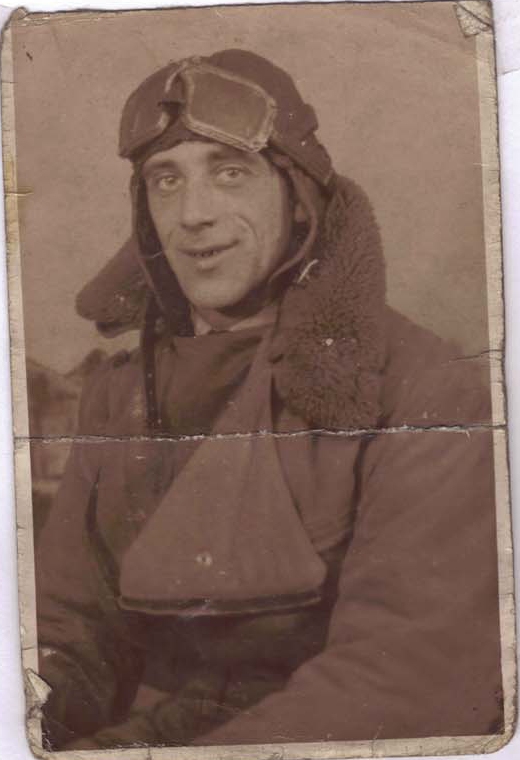 A
letter in the Falkirk Herald put me in touch with the Wright
family. Bob Wright, son of Robert Wright on LL145,
remembered his father telling him the story of the Skibbereen
landing but i
A
letter in the Falkirk Herald put me in touch with the Wright
family. Bob Wright, son of Robert Wright on LL145,
remembered his father telling him the story of the Skibbereen
landing but i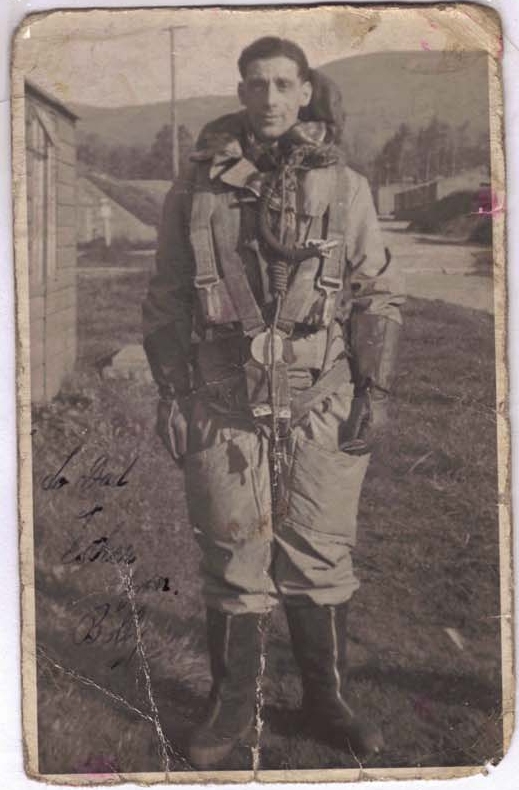 n
his owns words: "I have told this
story to friends for years, some from Ireland, not knowing
how true it all was."
n
his owns words: "I have told this
story to friends for years, some from Ireland, not knowing
how true it all was."
"My recollections of the story was that they made an
emergency landing in the south of Ireland (did not know
exactly where), they killed a cow, and he went into great
detail how they were shown a great time in the town and the
prison, I mean pub!!!!! My mum also told me she received a
telegram from the government stating my Dad was taken
prisoner (POW), but it did not say where. Unknown to her he
was having a whale of a time in Skibbereen, Cork"
"He never spoke much about the war and the RAF, but
I'm so glad he told me about the time he visited Skibbereen
on the 21st of April, 1944. Which believe it or not, is my
dad's birthday! Maybe that was the real reason for the
visit?"
"They also said he spoke
of "Titch"( Don Travers) highly. I'm sure I can remember him
saying that "Titch" banged his head on the door of the
Halifax, when exiting on the "marsh" in his hurry, which
they found funny as he was the smallest of the crew!"
The log book pages below show the record of the landing from
Robert's log book.
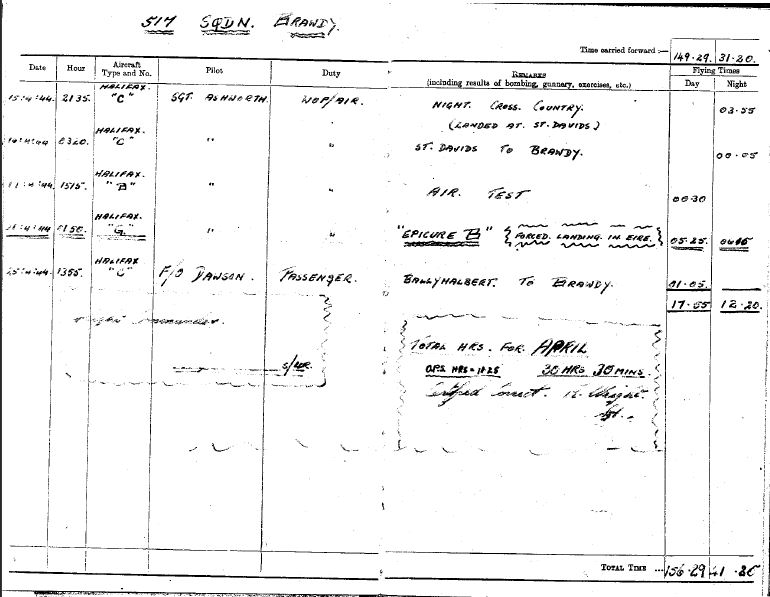
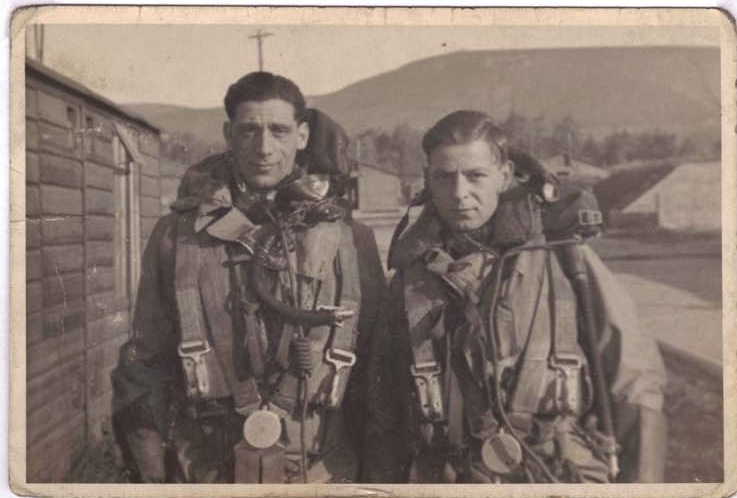
The photo above of Bob Wright (on the left) and another
airman in flying gear.
Robert Wright left the RAF in 1946 and finished his working life
with the British Aluminium plant in Falkirk. Robert was
married at the time of the landing and had two daughters until
Bob came along. Both Robert and his wife Mary have passed
away but they are survived by a large group of
grandchildren. In April 2008, Bob, his sister Rosina and
her husband visited Skibbereen where Gerald O'Brien showed them
around the local area. Robert reported "We had a good journey down and arrived just
after lunch and booked into the West Cork Hotel, where my
dad and the rest of the Halifax LL145 crew were housed in
1944. I must say it is a lovely hotel with friendly staff
who knew about the landing and were interested to talk to us
about it.
We did not do to much on the Saturday (19th) apart from walk
around the town and sample the local hospitality and down a
few Guinness's!!!!
That all changed on the Sunday when we met, as arranged,
Gerald O'Brien, who you had put me in contact with. What a
great man, what a character, what a gentleman. He made our
day and our trip so worthwhile. You would not believe his 74
years and the fact he was there at the landing at the age of
9.
After meeting in the hotel, he went through the old original
RAF photos of my Dad as well as old photos of our family. We
then showed him my dad's old flight log book, which being a
historian, absolutely amazed him. We all commented that the
book had returned to the west cork hotel, Skibbereen, again
64 years since it's first visit. He took great delight in
seeing the entry for the 21st of April 1944, "forced landing
in Eire".
Gerald then showed us his "and time stood still" book of the
local pictorial history of Skibbereen, which Gerald help to
put together. And there on page 138 is a picture of my dad,
Don Travers, and Fred Poune, as well as Frank Roche's
wonderful photos of the Halifax on the marsh. It is amazing
to think the plane and crew are a part of this towns
history.
Gerald was then kind enough to show us his old school and
recount the day the Halifax flew over the school as though
it was yesterday. We then took a trip up to a vantage spot
above the town to look down at the marsh, which is
undergoing lots of drainage work, but you could imagine in
your minds eye, the landing and what a difficult task it
must have been for Mr Ashworth to land the plane safely.
After that Gerald took us sight seeing. Firstly to Lough
Hyne, a beautiful tranquil place, then down to the lovely
harbour of Baltimore. He took us up to the breathtaking
cliffs at Baltimore Beacon where the Titanic sailed by on
her fateful journey. It really is beautiful part of the
world. After a late dinner, Gerald took us back to our
hotel, a full 6 hours after we first met, which just flew
by. We could not thank him enough.
We sat and recounted our day in the hotel bar with a few of
the staff. Gerald is a bit of a local celebrity. Next day,
the actual anniversary of the landing we met Gerald for tea,
before setting off back to Cork airport. He wrote a
thoughtful message on the Skibbereen book and gave me the
book. An amazing gesture."
Frederick John Poune was born in 1924 to Edith Poune in
Tenterden, Kent. The 1939 register finds him living with
his mother and stepfather Norman Addy. His occupation is
listed as Grocers and Bakers Errand Boy. As luck would
have it, there was but one Poune named in the 2007 phone
directory for Derby. A letter to that address received a
warm reply from Sue Poune, Fred's second wife.
Sue remembered that: John often
spoke of his time in the RAF and I am aware of the landing
in Ireland. He mentioned the unfortunate incident with
the cow, and being plied with lots of booze and being
welcomed rather than being interned which I understand they
should have been by a neutral country.
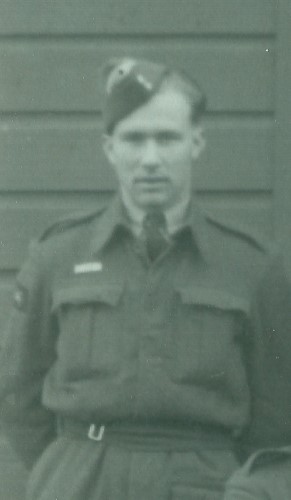 Fred Poune was later known as John and passed
away in 1992 but he left after him an impressive collection of
photographs and his log book. The Derby Evening Telegraph
of 11 October 1943 recorded the marriage of Fredrick Poune,
RAFVR from Woodchurch, Kent to Joyce Smith from 81 Boulton St,
Alvaston, the address he later gave to the Irish Army.
Fred Poune was later known as John and passed
away in 1992 but he left after him an impressive collection of
photographs and his log book. The Derby Evening Telegraph
of 11 October 1943 recorded the marriage of Fredrick Poune,
RAFVR from Woodchurch, Kent to Joyce Smith from 81 Boulton St,
Alvaston, the address he later gave to the Irish Army.
Investigation of these photos and documents showed that this was
not the first time some of the crew were in Ireland as six of
them at least were put together as a crew whilst training with 7
(Coastal) Operational Training Unit ( (C) O.T.U.) at Limavady in
County Derry, Northern Ireland.
It would appear that local Skibbereen photographer Frank Roche
swapped addresses with F J Poune and sent him copies of photos
taken on the day of the landing and also of the dismantling of
'George', as the plane came to be referred to locally. On
leaving the RAF, John worked for the railway works in
Derby. After a time he joined Derbyshire Constabulary, on
the beat and then in CID. When he left the Police he
started work as a Private Investigator. Investigation of
John's log book shows that he first flew with Arthur Ashworth on
7 September 1943 in Wellington, number 52 from Limavady in
Northern Ireland. They then went on the MCU based at Tiree
and from there to 517 Squadron where John's first flight was on
23 February 1944 with Ashworth in Halifax 'K'. John's last
flight with Ashworth was on 12 June 1944 and Arthur would be
lost little over a month later in the action described above.
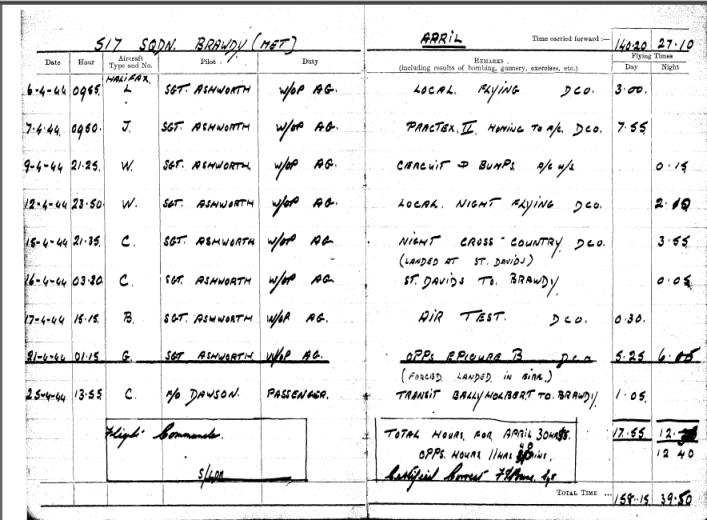
John's log book goes on to show the 517 Squadron missions that brought him to Port Lyautey in French Morrocco, Gibraltar and Rabat, Casablanca. Their time with 517 Squadron can be traced in the Operations Record book. As explained by John Barthram below, as he was a Met Observer, he was not teamed up with the others as a crew member but rather moved about between crews on an as required basis. The others, with the exception of Donald Travers, had met together while training in Northern Ireland. The ORB for February 18th, 1944 records the following:
F/S Lawes (Nav), Poune, Mitchinson, Wright, (WAGS), Sgt Ashworth (Pilot) posted from Tiree
Five days later they are recorded doing a test flight, whereas
John Poune log book shows other training missions during
February and March and early April 1944. Some members of
the crew were posted to carry out short further training
courses. The mission on April 21st was actually their
first ever operational mission with the Squadron.
The crew stayed with 518 SQuadron into peacetime, with Travers,
Wright, Poune and Mitchinson being posted out in September and
October 1945 to 1674 Heavy Conversion Unit. Lawes had been
posted out in June of 1945 to an RAAF Holding unit.
The following photo, sadly damaged, of six airmen from the
Poune collection includes some of the enlisted members of the
crew, Lawes, Poune, Mitchinson, Wright and Travers.
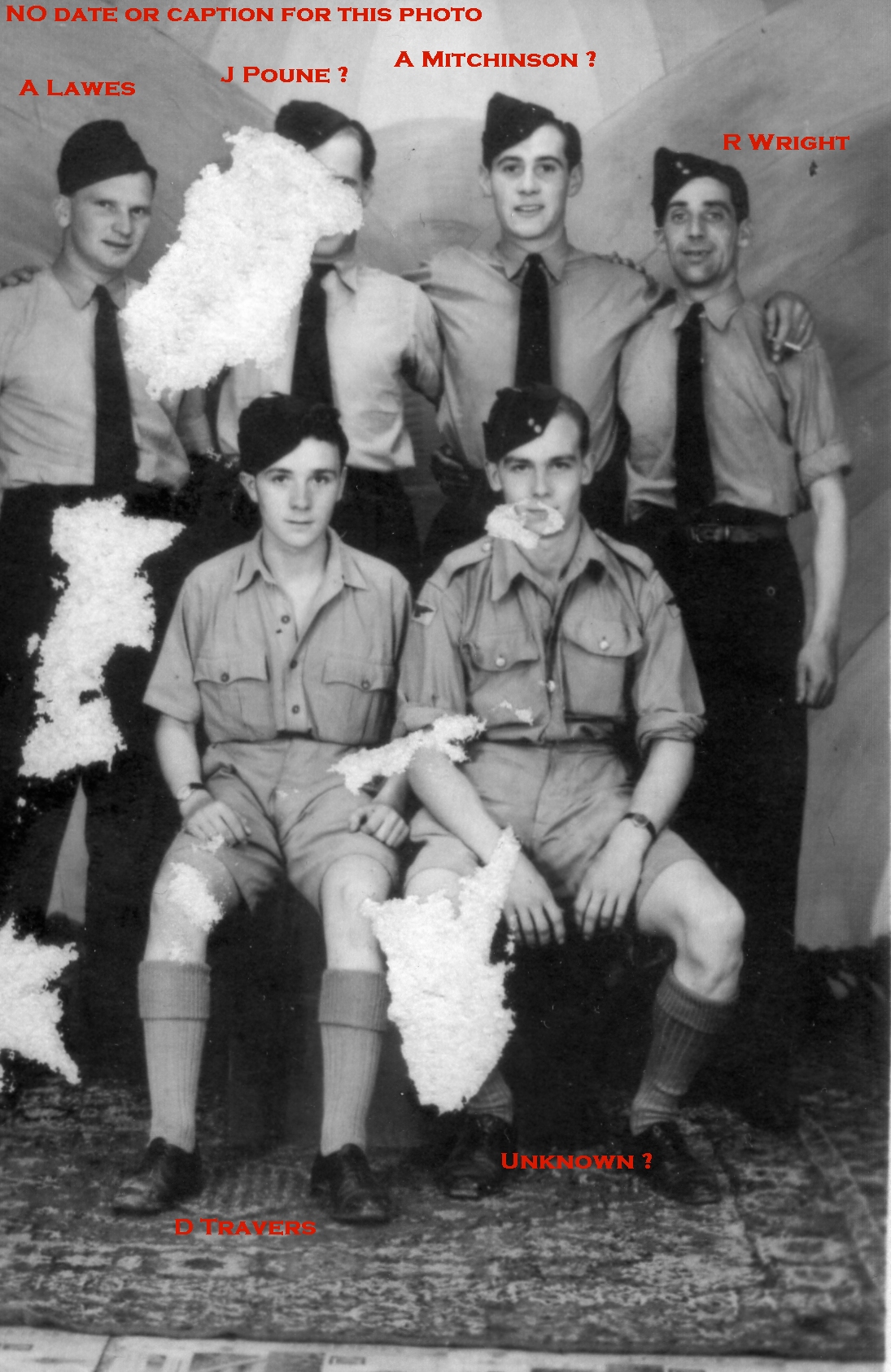
The photo below then seems to show most of the crew of LL145
later in 1944 after their pilots became Kemp and Pepper.
Standing, left to right are: Travers, Mitchinson, Unknown
and Poune.
Sitting: Lawes, two pilots and Sgt Wright. It assumed that
these two men sitting are Pepper and Kemp.
It is possible that the unknown man is a Sgt K F Hall, a met
observer who flew with the crew many times at the end of 1944
and into 1945.
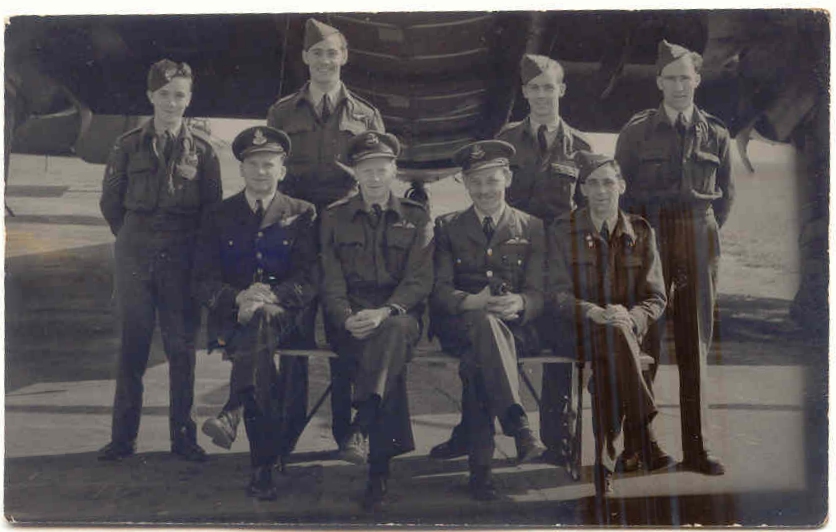
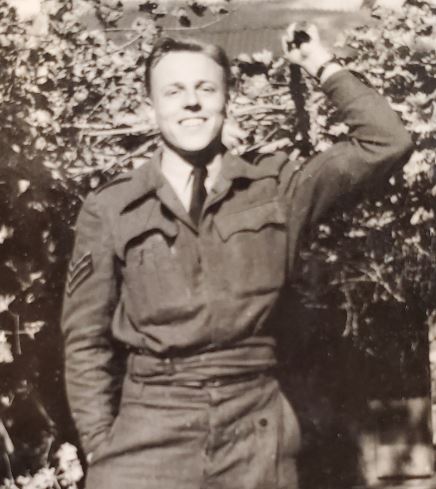 John A. Barthram, son of Maud
and John Barthram, in 1944 was the Meteorological Air Observer
(MAO) on board Halifax LL145 and he described in an email from
28th January 2007 what happened to the crew thereafter!
John A. Barthram, son of Maud
and John Barthram, in 1944 was the Meteorological Air Observer
(MAO) on board Halifax LL145 and he described in an email from
28th January 2007 what happened to the crew thereafter!
“You may be interested in my
recollections of the flight - errors and omissions
accepted !! One incident, which I am sure was not mentioned
at the debrief, was that due to an unfortunate
misunderstanding the pitot head cover was left on during
pre-flight inspection. The mistake did not show itself until
the aircraft was gaining speed on take-off, then
too fast to abort. The aircraft was very heavy with
extra fuel tanks in the bomb bay. The problem was overcome
by using an axe to smash the Perspex window in the bottom of
the fuselage just below my “desk” at the front. By lying
sideways against my seat the Canadian ( ? ) managed to
extend his arm far enough out to remove the cover. I had
tried but found the airstream too strong to reach that far,
so full marks to the RCAF/RAAF. Also I then went back to
help pump up the undercarriage as its hydraulics had failed
! As far as I remember the weather was benign though a lot
of cloud and the trip then seemed routine. The outbound leg
finished with a “ box climb “ to about 18,000ft ( 500mb ) .
At around this time the radio operator told me he had been
unable to pass my last two messages so hold the next for the
time being. Apparently no radio bearings could be obtained ,
and also no astro-nav. We were now returning and to conserve
fuel a gradual descent (not box ) was made. Eventually we
were placed well west of track and too low on fuel to make
England. We diverted to Skibbereen which was marked as an
emergency landing ground on our maps. Arthur made a very
good landing ( wheels pumped down ) though it did entail
going through a dividing hedge/wall that separated the two
fields that were the landing area, and it was said
we hit a cow!
We were taken to a nearby hotel - I can’t remember the name
but it would be to the S-SE of the town and near a bridge.
Here we were generously but excessively supplied with strong
drink and my memory definitely fails ! I do remember
somebody saying that a Court had been in progress in
the town and when they heard an aircraft had landed just
everybody left to look ! I think it was one of the
solicitors that told us this, and vaguely I think he was in
Army uniform, Within days we were taken by car to Belfast
and debriefed at Stormont - they may have more
accurate records.
John Barthram flew only once or twice with Arthur Ashworth's
crew and hence did not know the men well. Hale and hearty
in 2021, John was kind enough to share the two wartime photos of
himself that had only recently been found, including this one of
him on a horse!
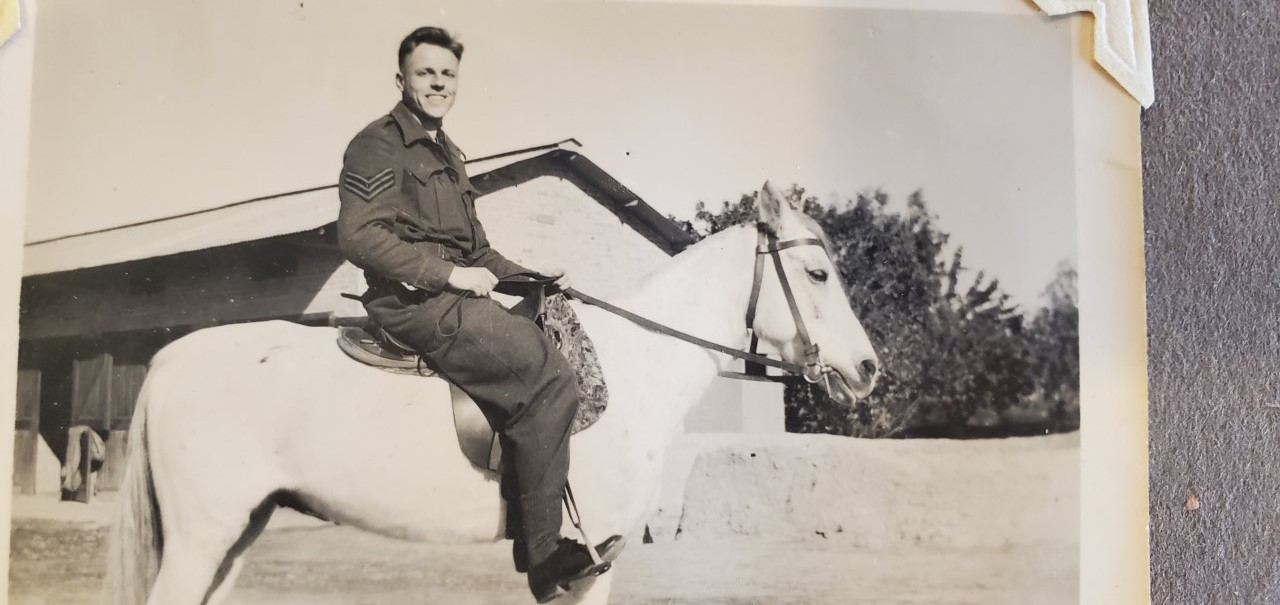
And what of the Halifax, LL145? This was one of a batch
of almost 500 aircraft built by the Rootes Securities
company. It was a Halifax Mark V aircraft powered by four
Rolls Royce Merlin 22 engines. While it was able to land
in 'The Marsh' it was not possible to fly the aircraft out and
so the Irish Air Corps proceeded to dismantle the aircraft in a
23 day operation bearing in mind that the aircraft's basic
dimensions were a wing span of 104 ft (31.7 m) and a length of
71 ft 7 in (21.8 m). The disassembled aircraft was
then trucked across the border.
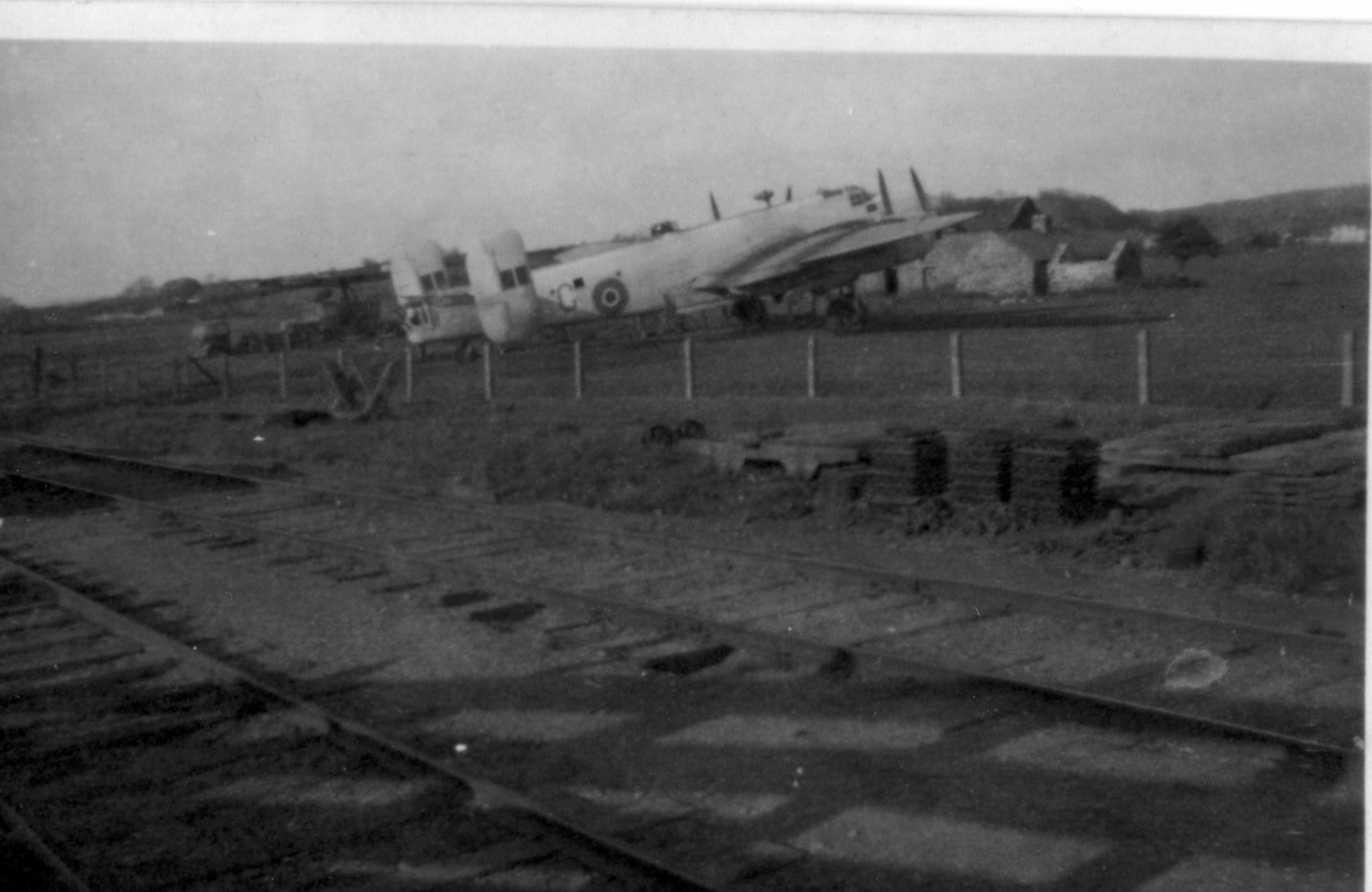
Above: Halifax LL145 appears to have been moved away from
the outskirts of town, but must still have been easily
visible. Just behind the tail one can see two of the
recovery trucks sent to take the aircraft away.
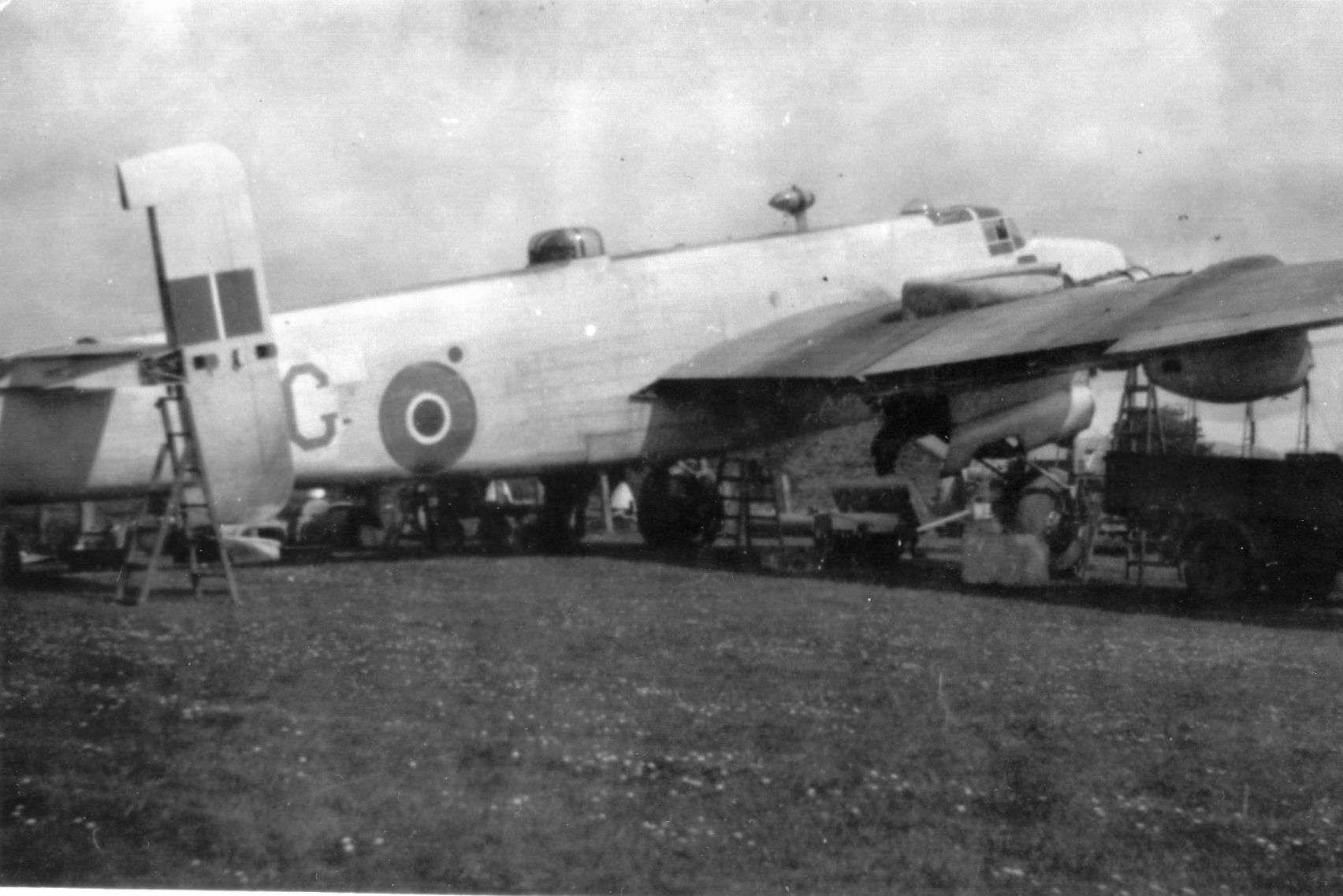
Above: The dismantling of LL145 has begun, elevator and rudder
of the tail plane has been removed, and the engines on the wing
are already taken off.
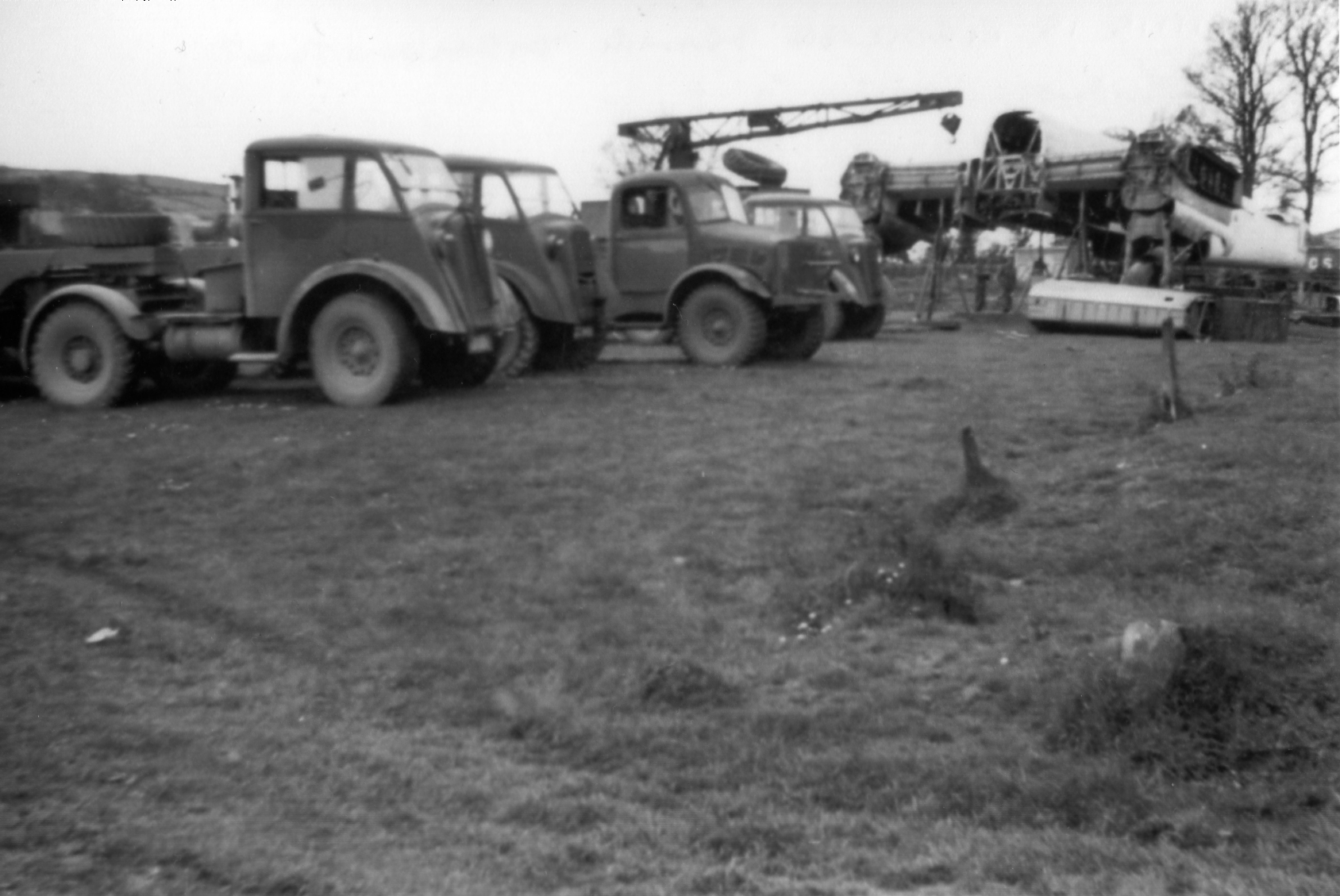
Above: Halifax LL145 in the process of being dismantled.
The vehicles in front of the aircraft may be Irish or Royal Air
Force recovery vehicles. The Operations Record Book of the
RAF's 226 Maintenance Unit, based in Northern Ireland, records
very briefly that during the month of May 1944, one Halifax was
salvaged from EIRE. The Irish Army reports on this landing
record that it took 23 days to complete the salvage of the
aircraft.
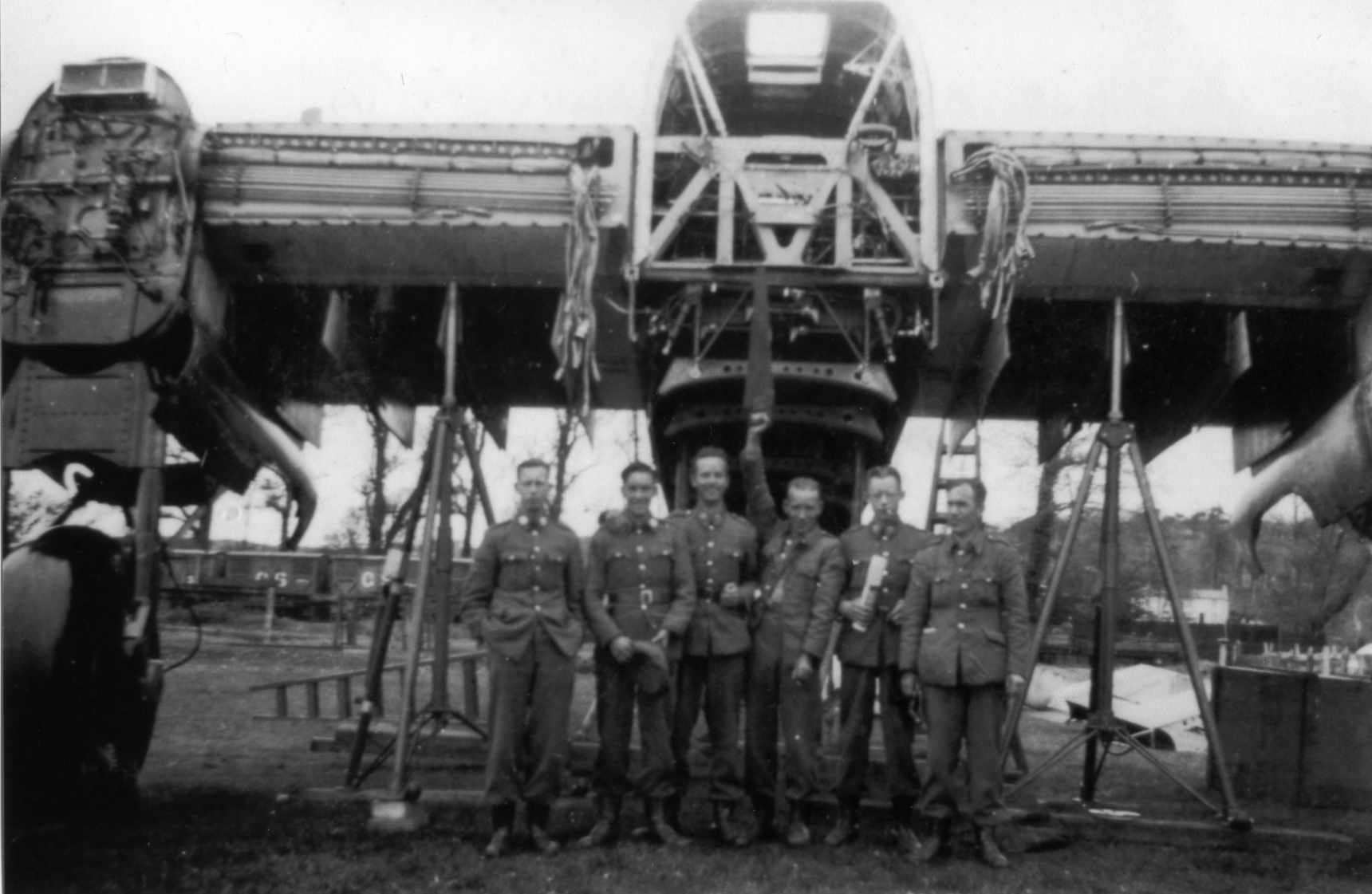
Above: A group of Irish Army soldiers posed beneath a rather
sorry looking LL145. The nose has been removed along with
engines, wing leading edges.
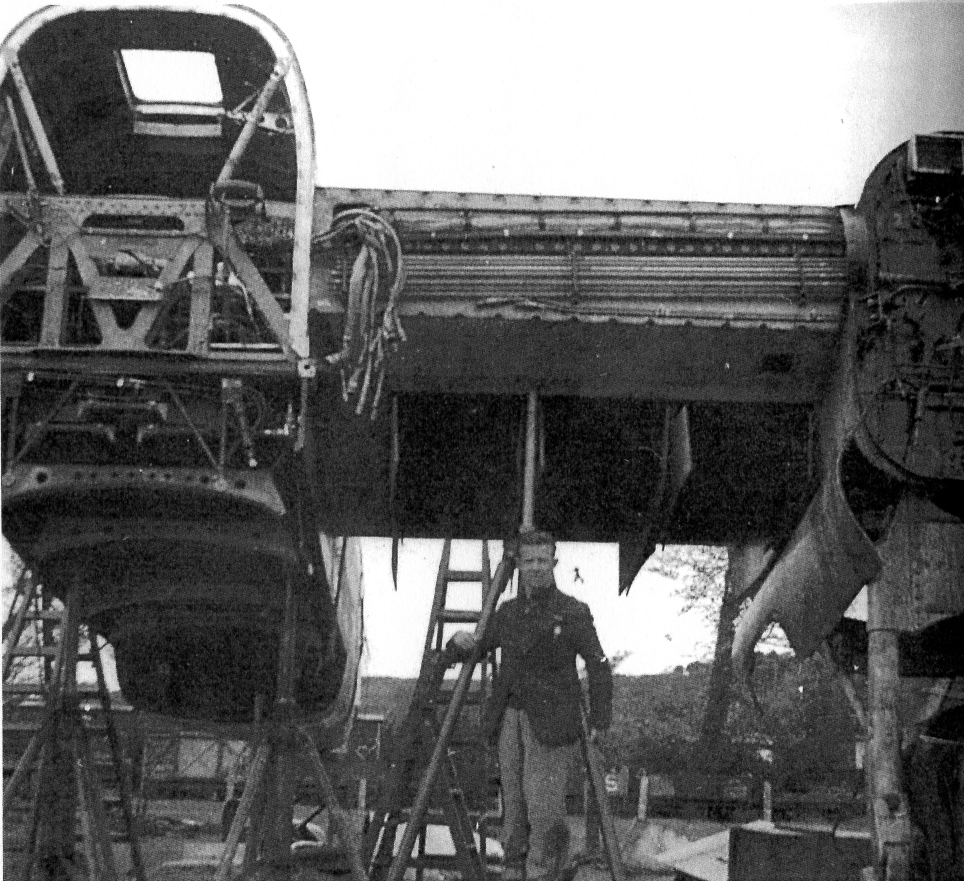
Above: Frank Roche pictured stood under the dismantled hulk of
LL145.
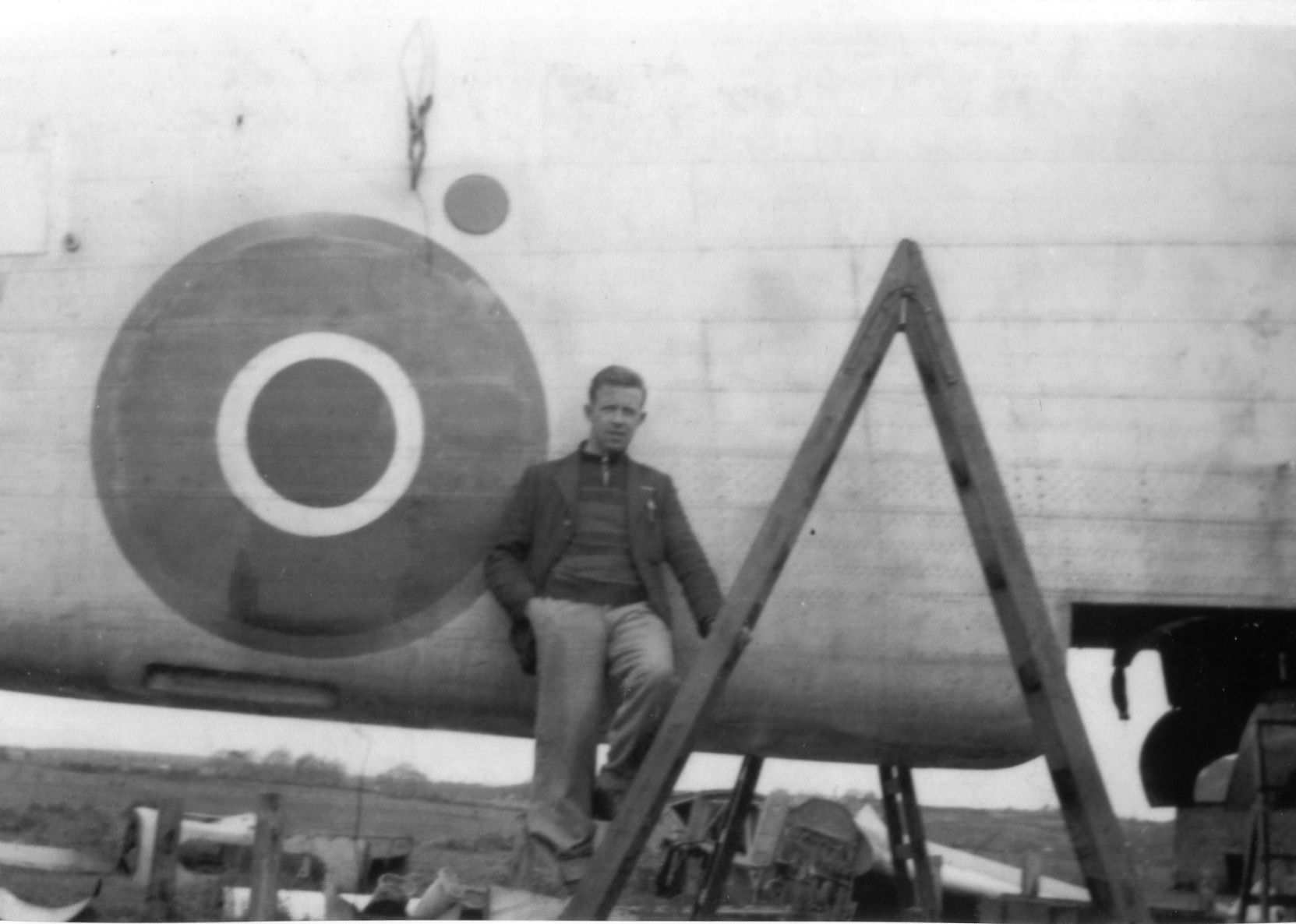
Above: Frank Roche standing behind the aircraft bomb bay, with
bay doors removed.
During the removal of wreckage, a low loader driven by an Air
Corps driver jack knifed and damaged a wall on the main street
of Dundalk on April 14th. This is notable since the Irish
Army G2/X/1295 file contains a copy of a report filed by F/Lt
Herbert Stanley Moore of 226 Maintenance Unit Royal Air Force to
the Senior Intelligence officer, HQ, RAF Northern Ireland
explaining that jack knifing was not uncommon with these
vehicles and that no blame should be apportioned to the Irish
driver. The equipment was RAF equipment and he was making
arrangements to have the damaged vehicle recovered from Dundalk.
The Air Ministry Form 78 history of the aircraft records its
being taken on charge by 45 Maintenance Unit (MU) on 2 Dec 1943
and then assignment to 517 Squadron on the 20 Dec 1943. The
records of the Civil Repair Organisation at Short & Harland,
Belfast show LL145 as being received on 19 May 1944 for Cat B
damage repair, the accomplishment of which was signaled on 12
December that year. The Form 78 records its 'Repair in Works'
during that time and that it was awaiting collection as of
November 19. It was delivered to No 45 MU at Kinloss
three days later. It was transferred to 44 MU on 4th Jan
1944 and appears to have played no more part in teh war.
It is recorded as being converted to scrap when struck off
charge in January 1947. Thus ended its very short service
life.
517 Squadron formed from No 1404 Flight at St Eval on 11 August
1943. It continued to conduct meteorological
reconnaissance duties after this. Intended to be equipped with
Halifaxs, it used Hudsons and Hampdens until October.
In between the Hudsons leaving in September 1943 and the arrival
of the Halifaxes in November, four B-17s of the 379th Squadron
USAAF were attached. Halifax Vs arrived in November and at
the same time the squadron moved to St David's. In
February 1944 it moved again, this time to Brawdy, where
it received Halifax IIIs in February 1945. The following
November a further move took place to Chivenor, where the
squadron disbanded on 21 June 1946.
And what of the man who took those superb photos of LL145 in
Skibbereen?
Frank Roche replied to me in 2008 to say hello. He lived
then in Dublin having retired from his job in the motor industry
some time before. He has two sons but sadly his wife
passed away some time ago. In his letter he did say 'we did everything for the crew during the
time they were in Skibbereen. I wrote to Sergeant
Poune often." With his card he included
this article which was written about him at his
retirement. Frank passed away in June 2015 in Dublin.
